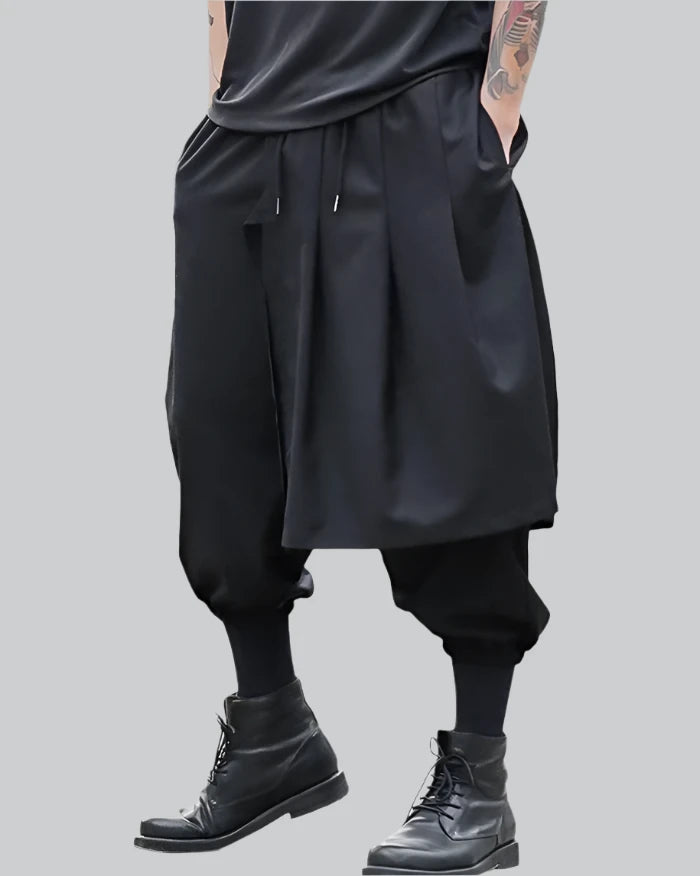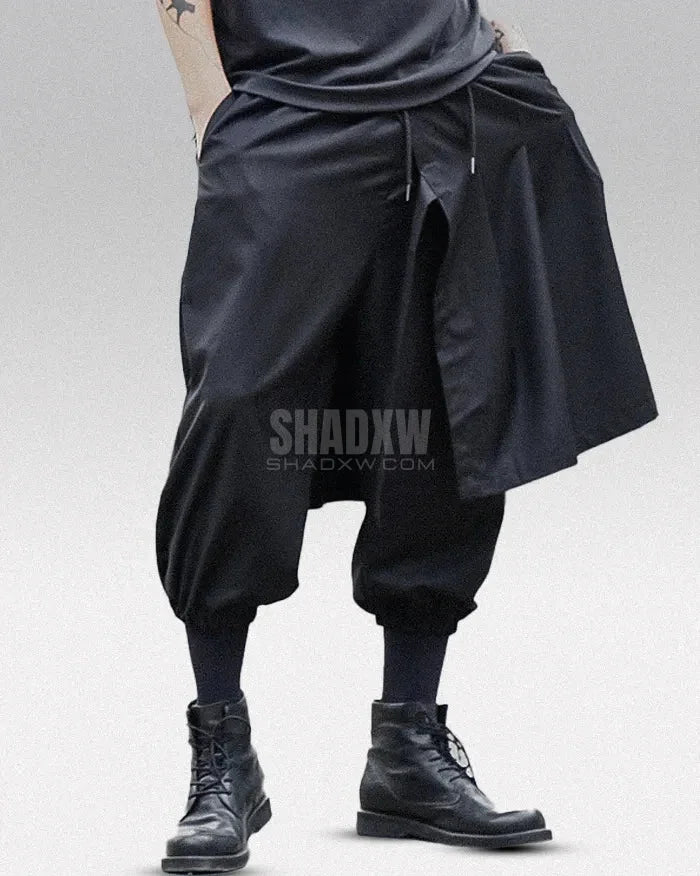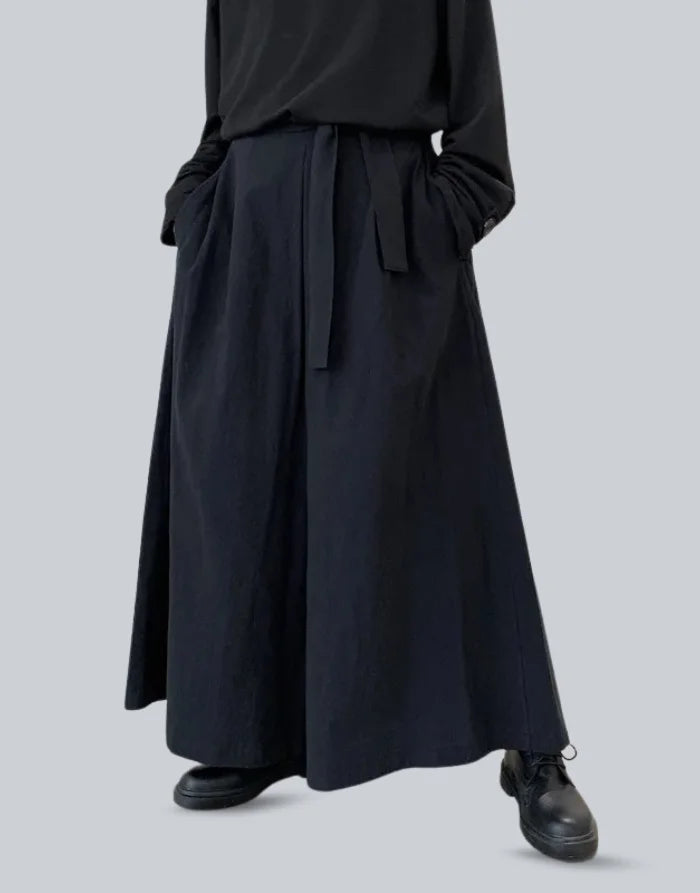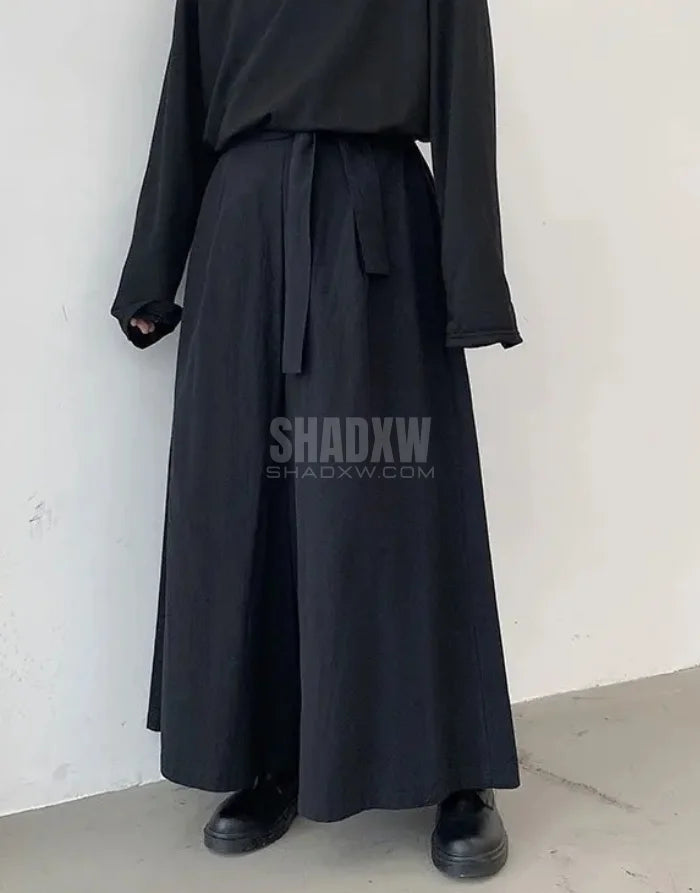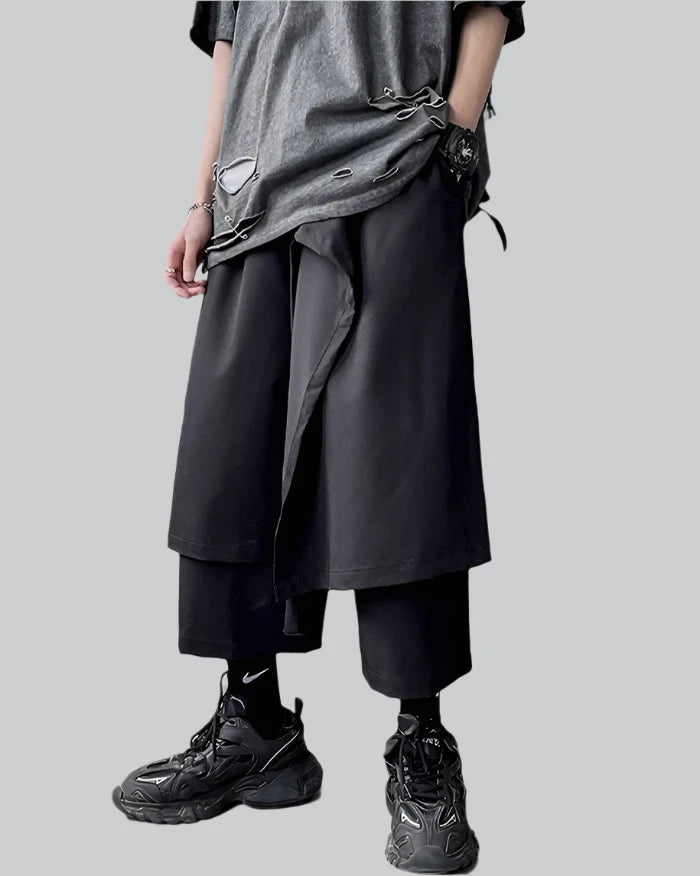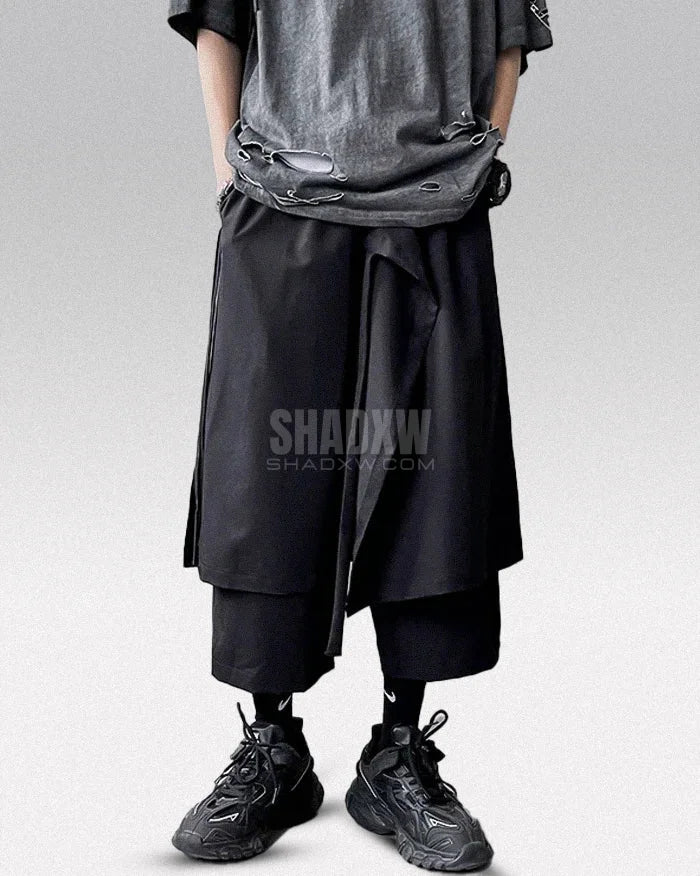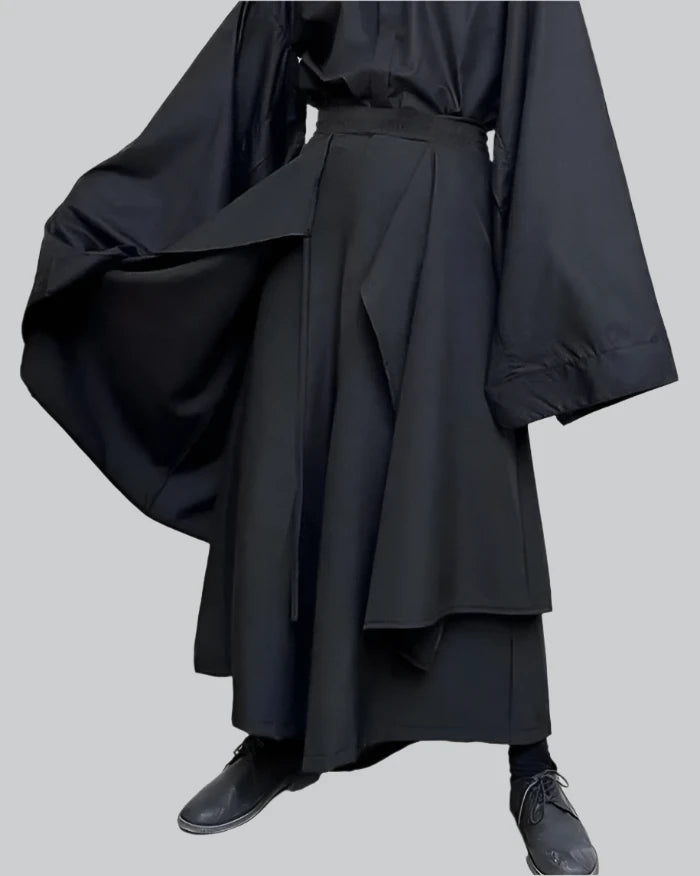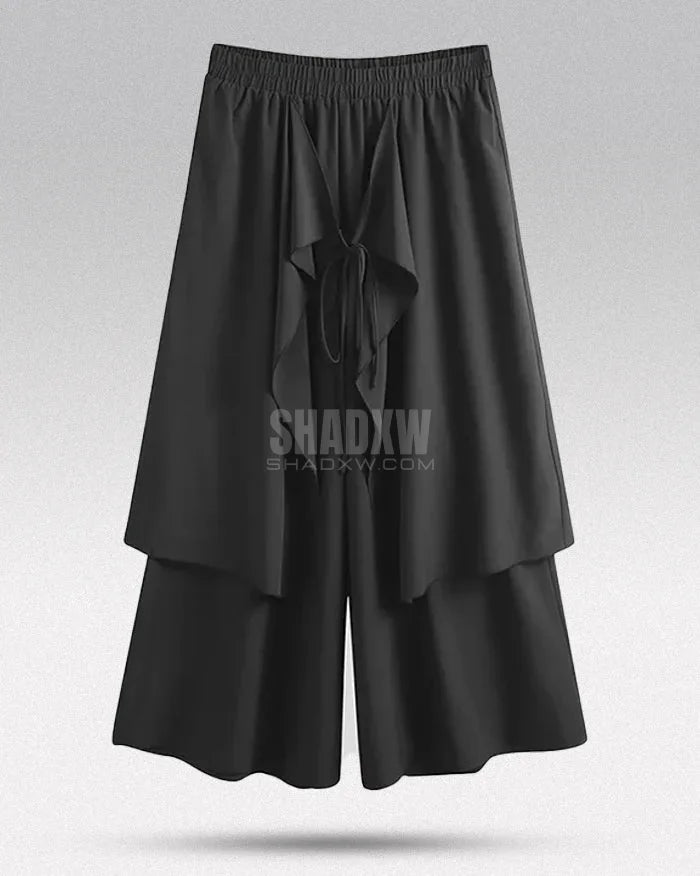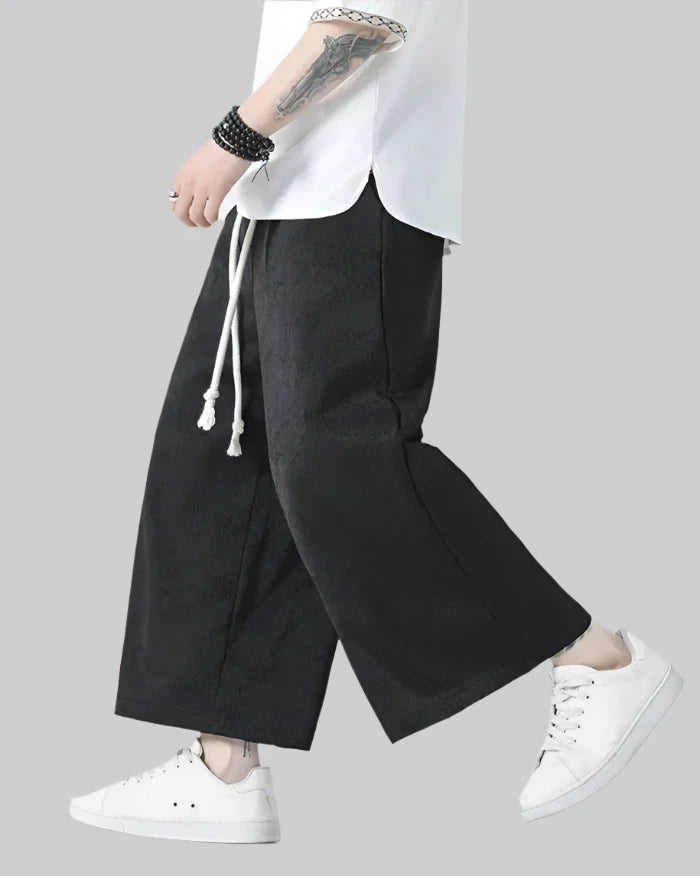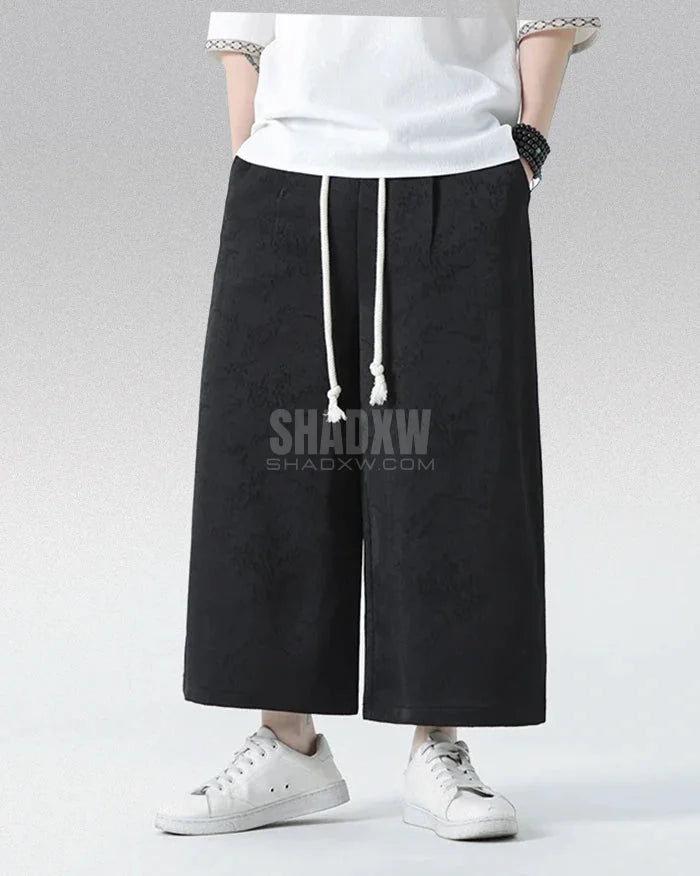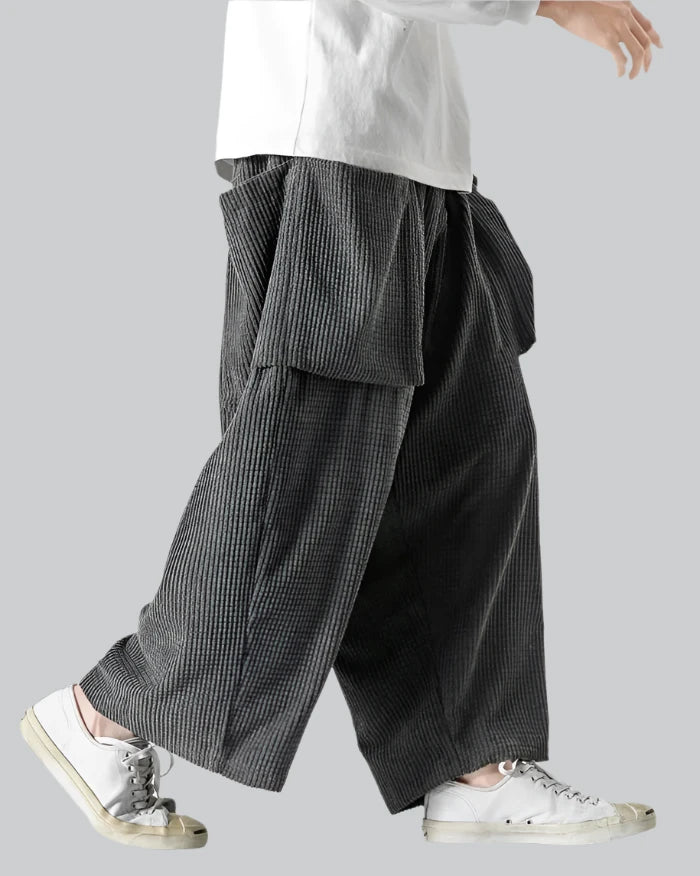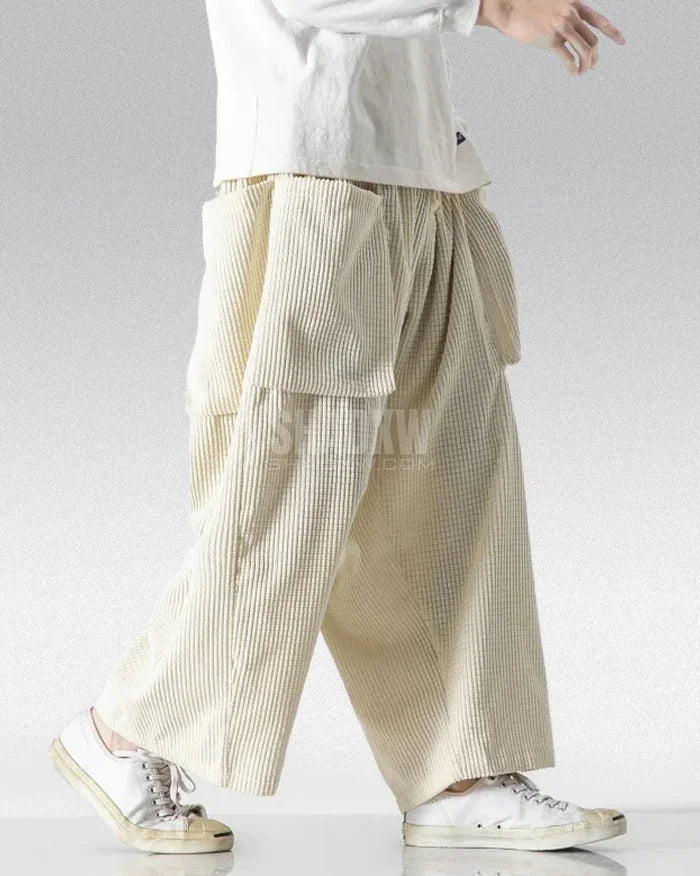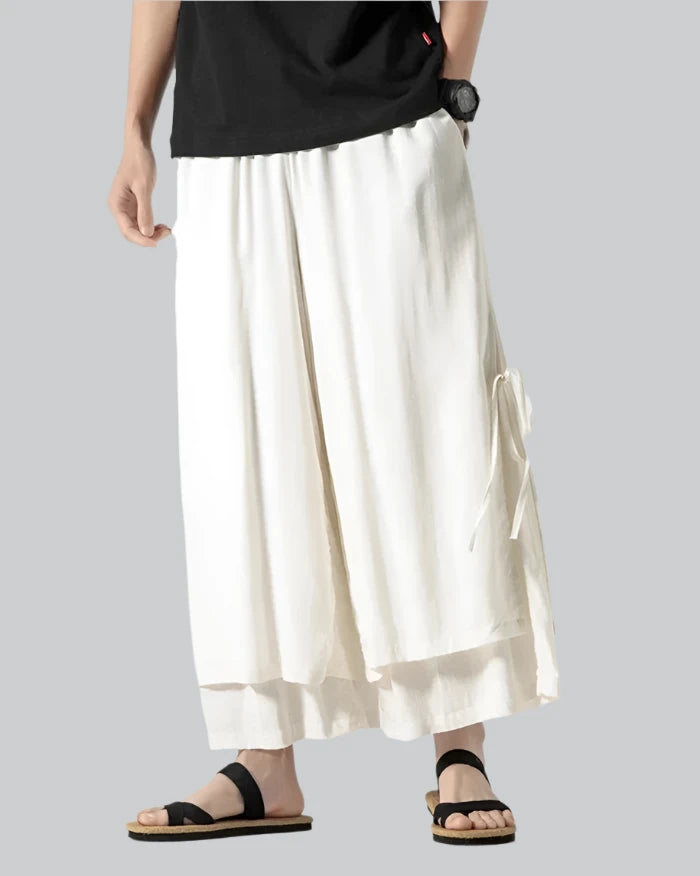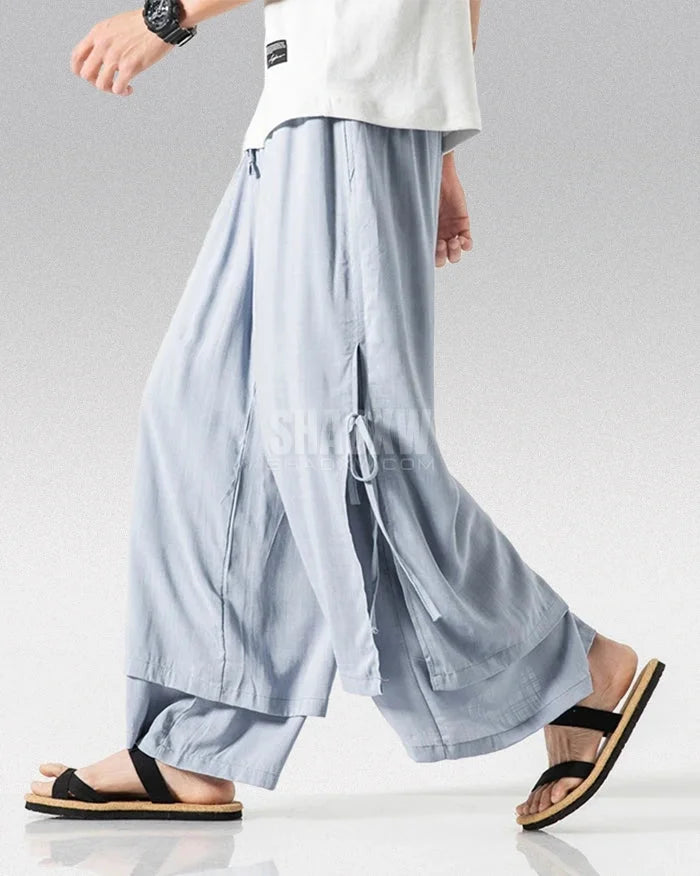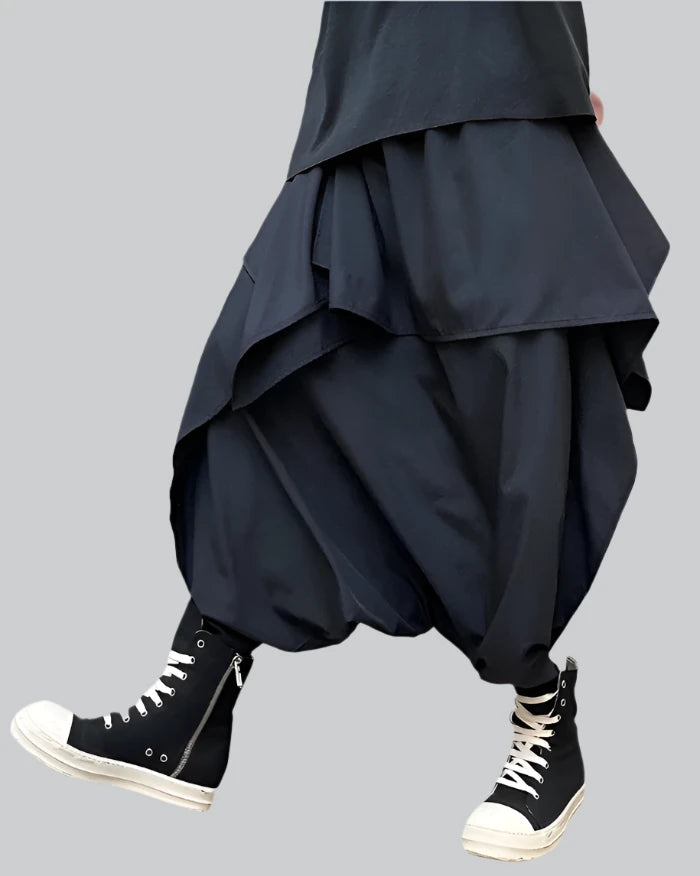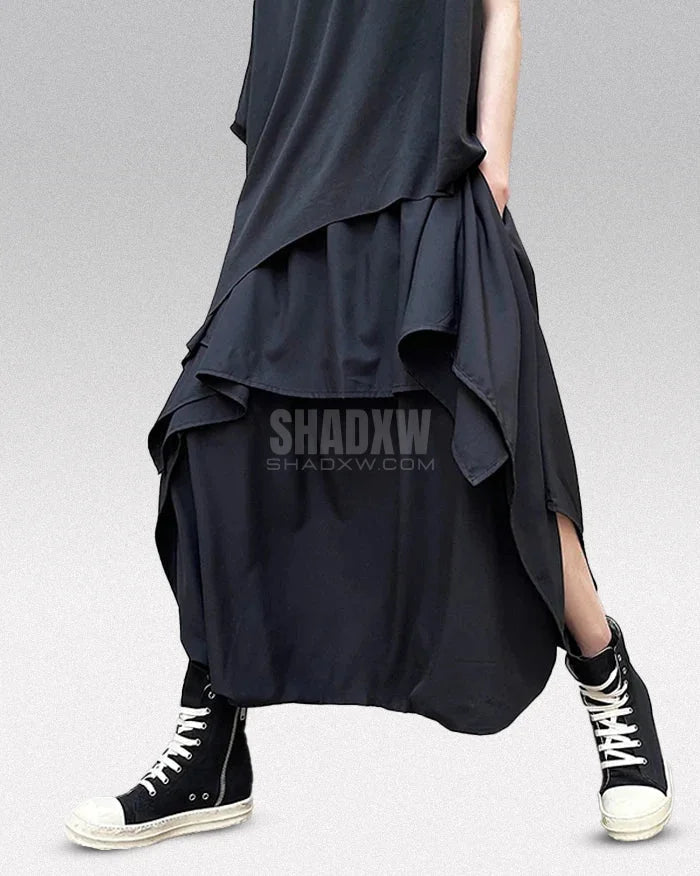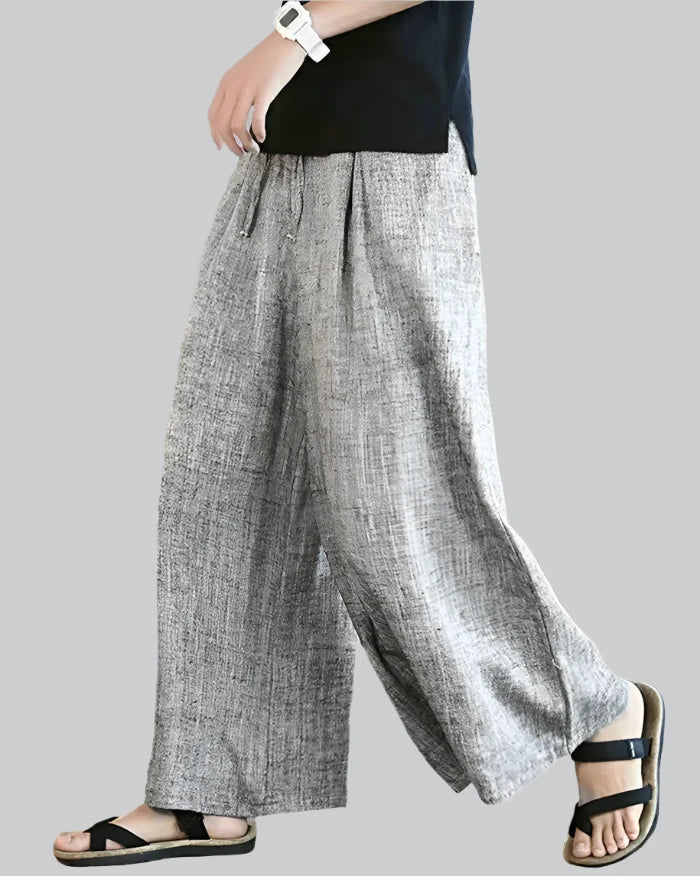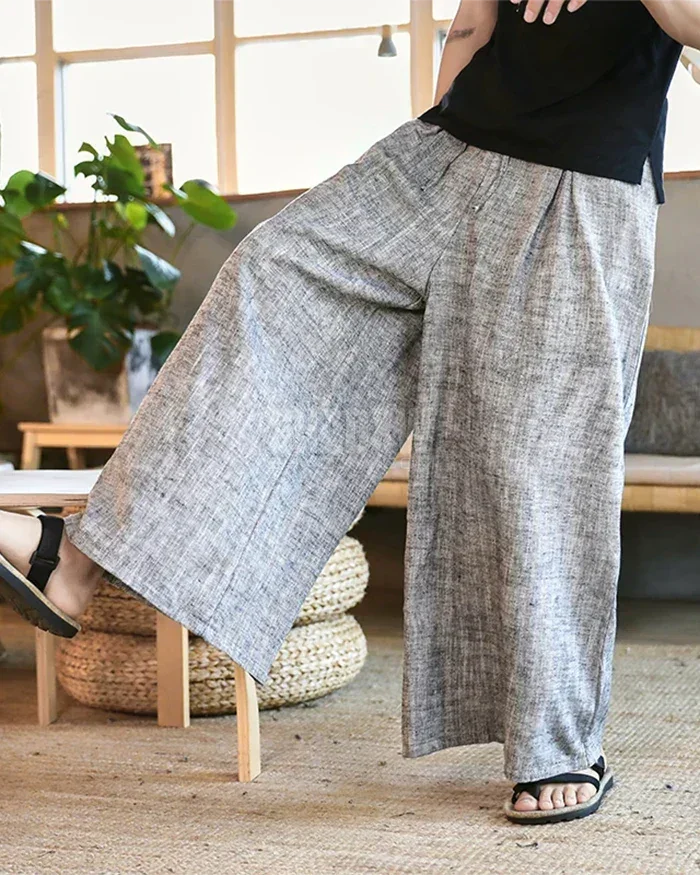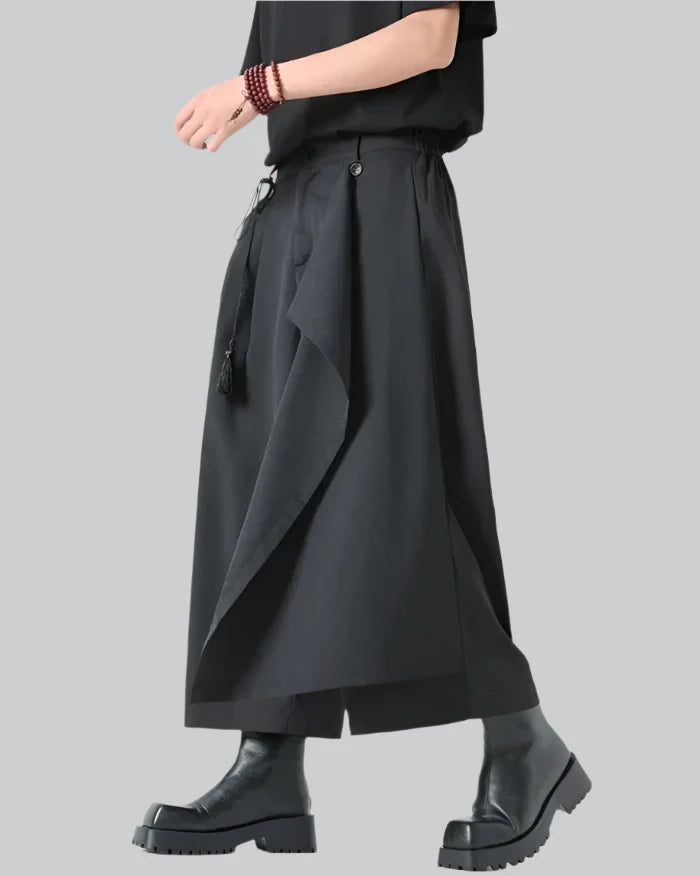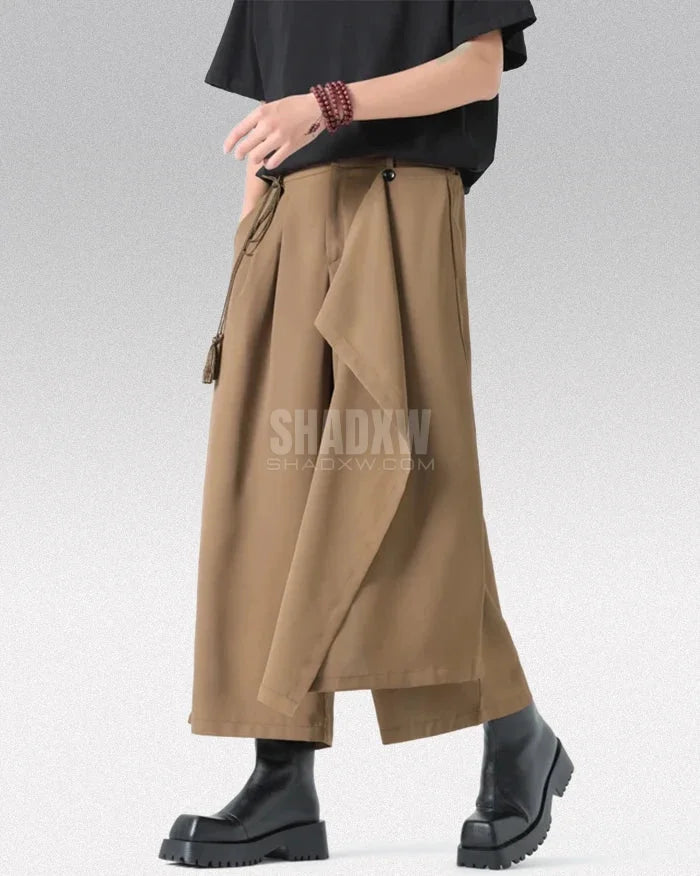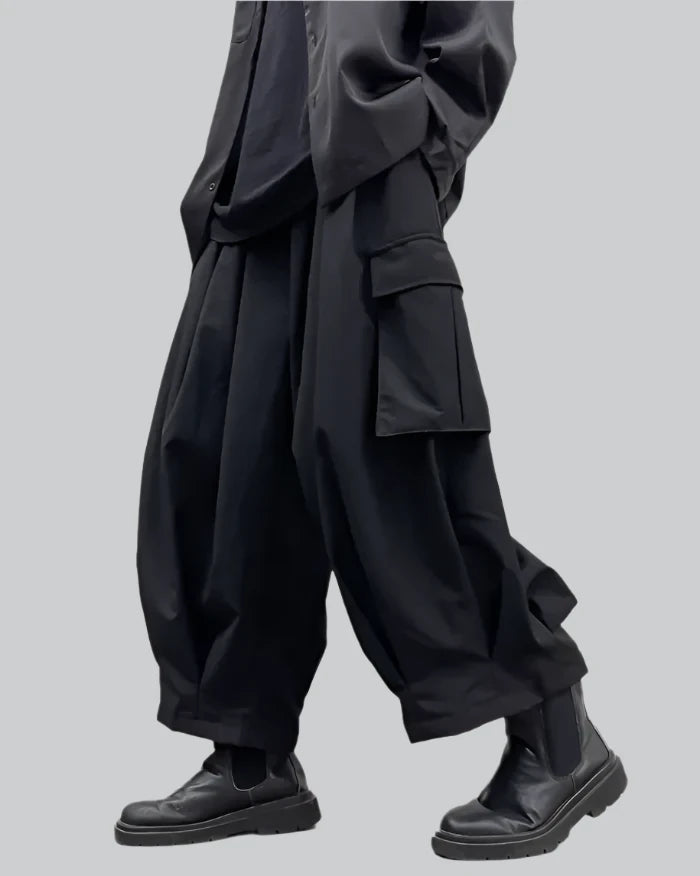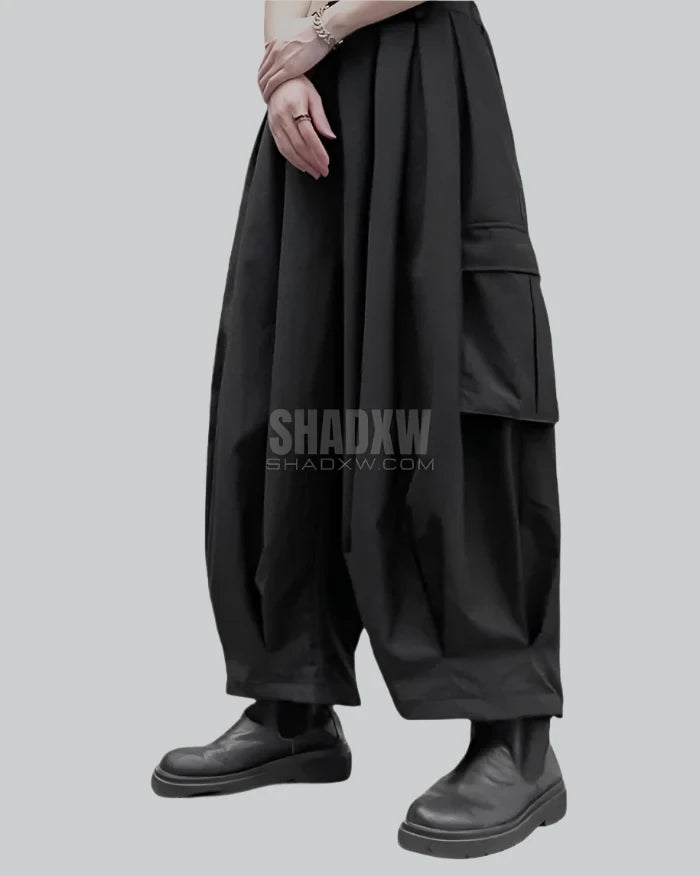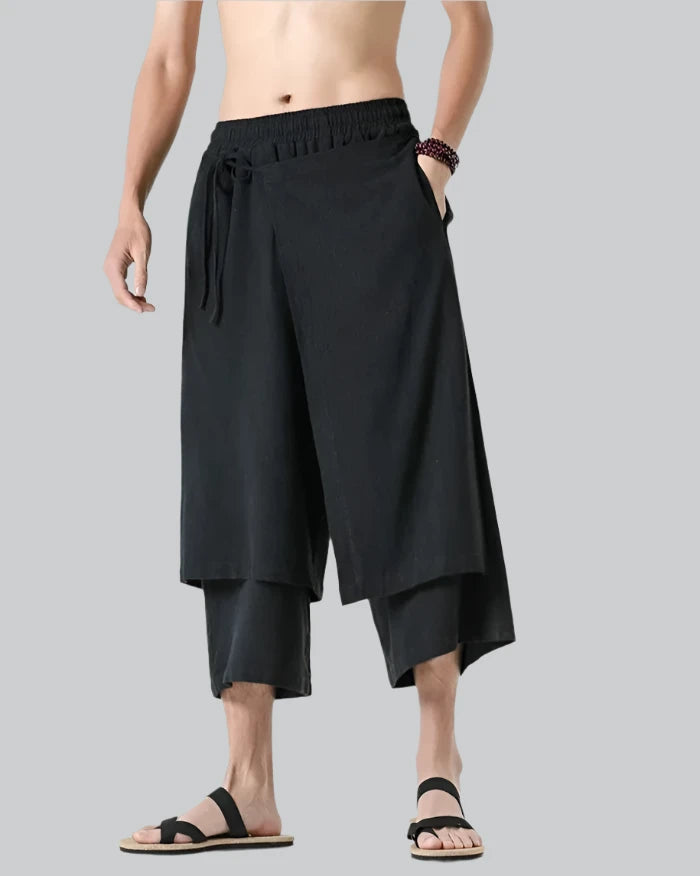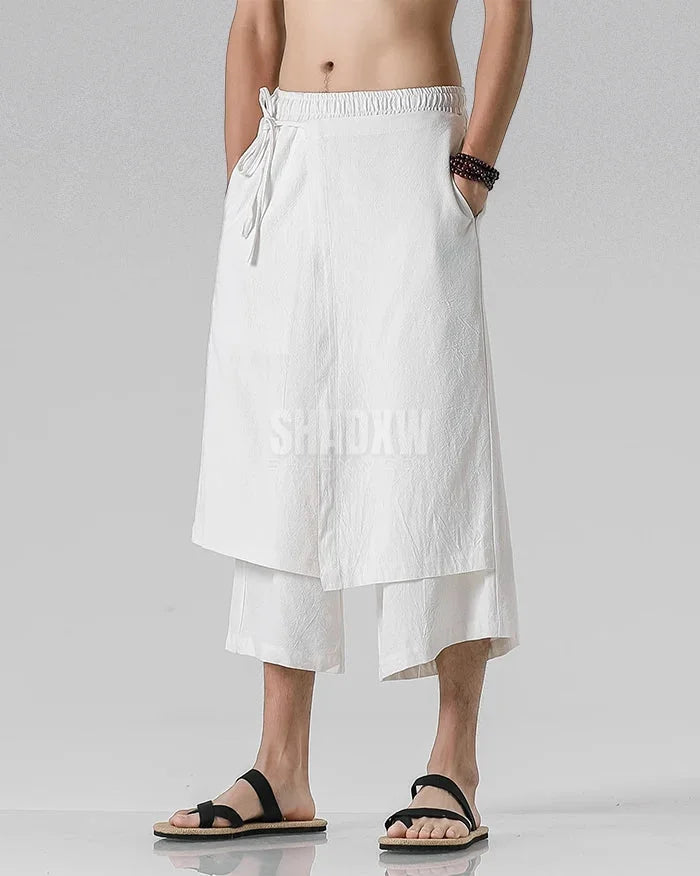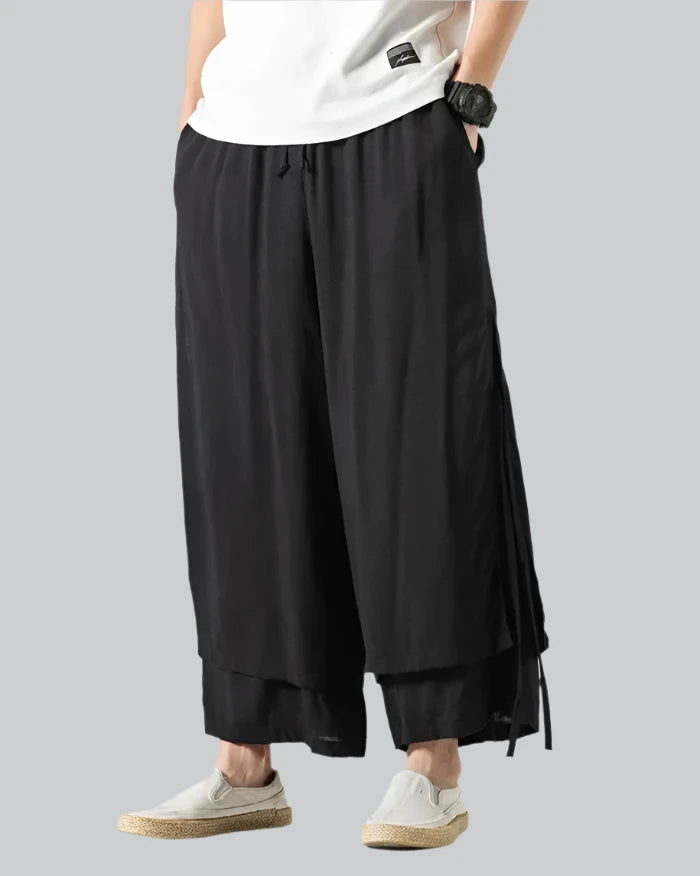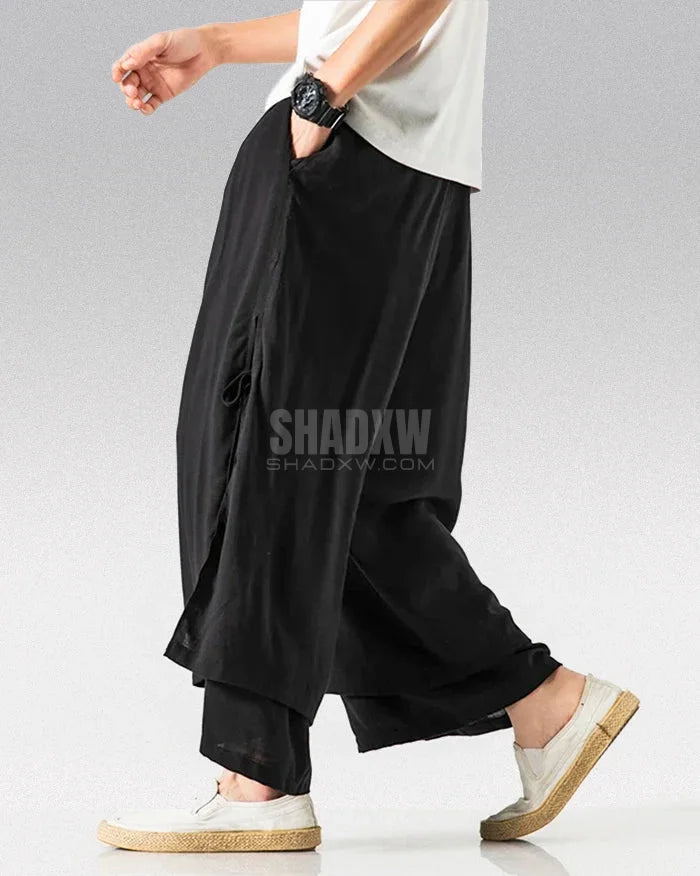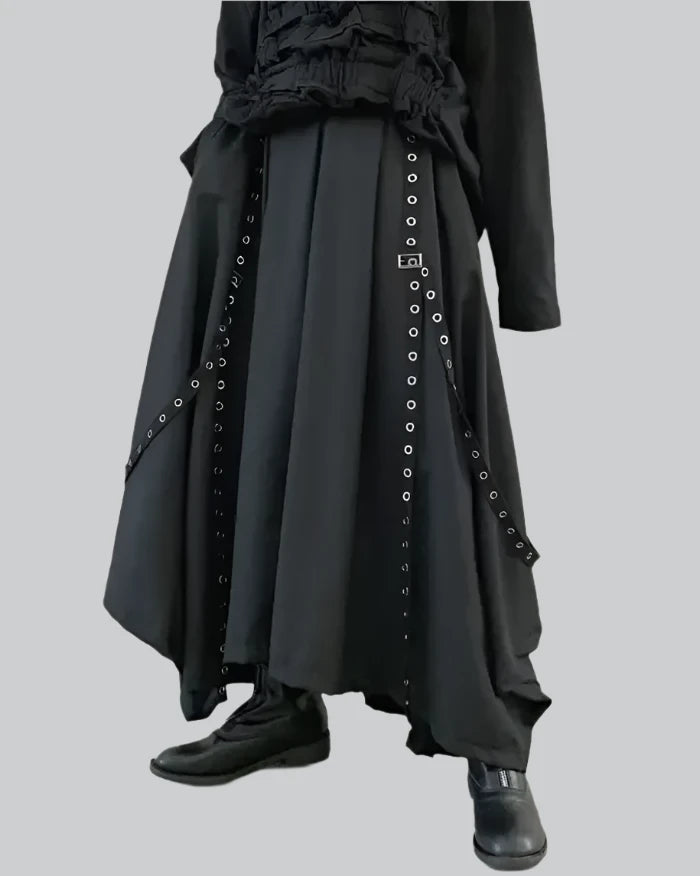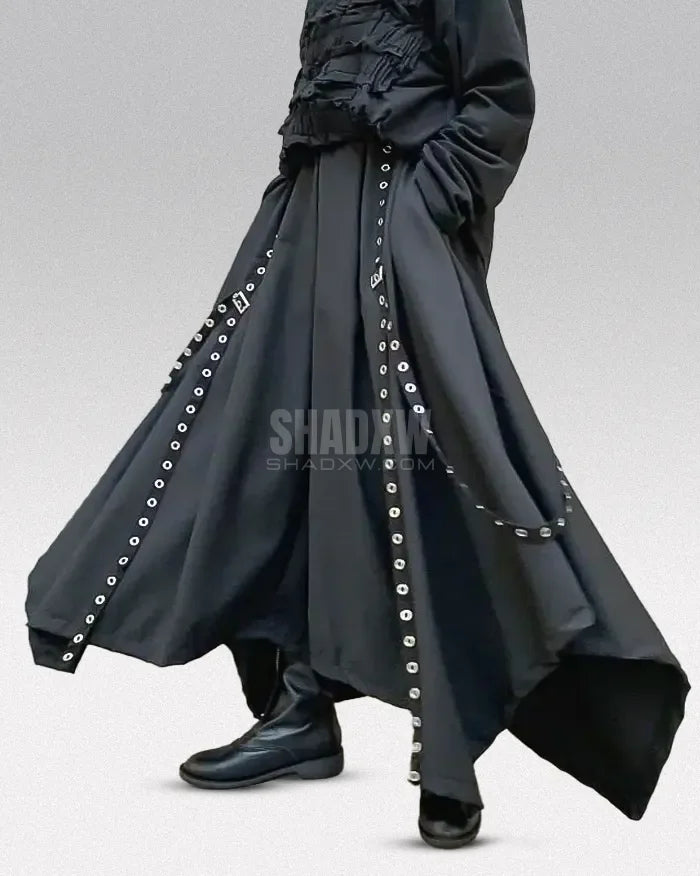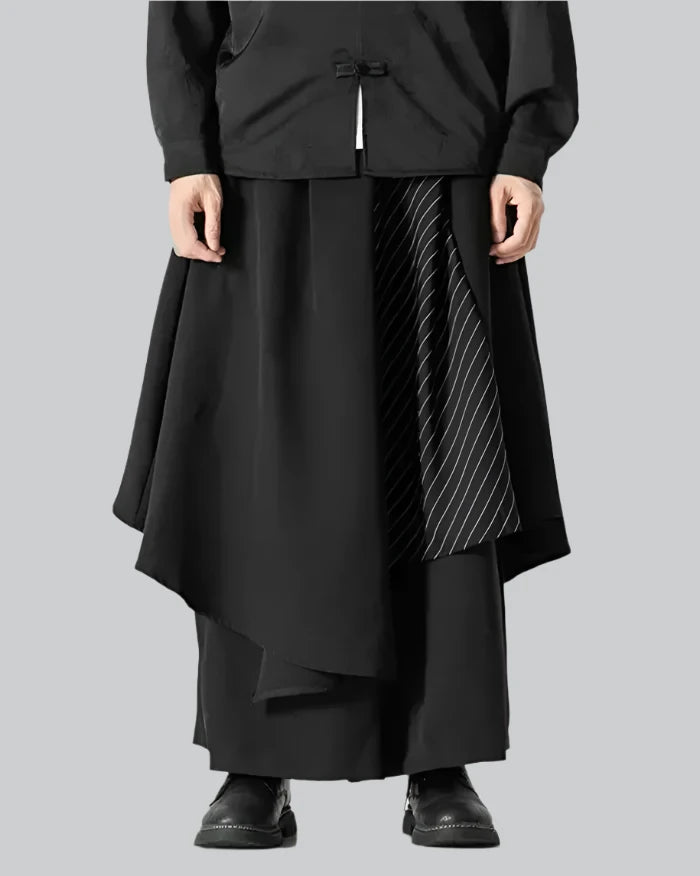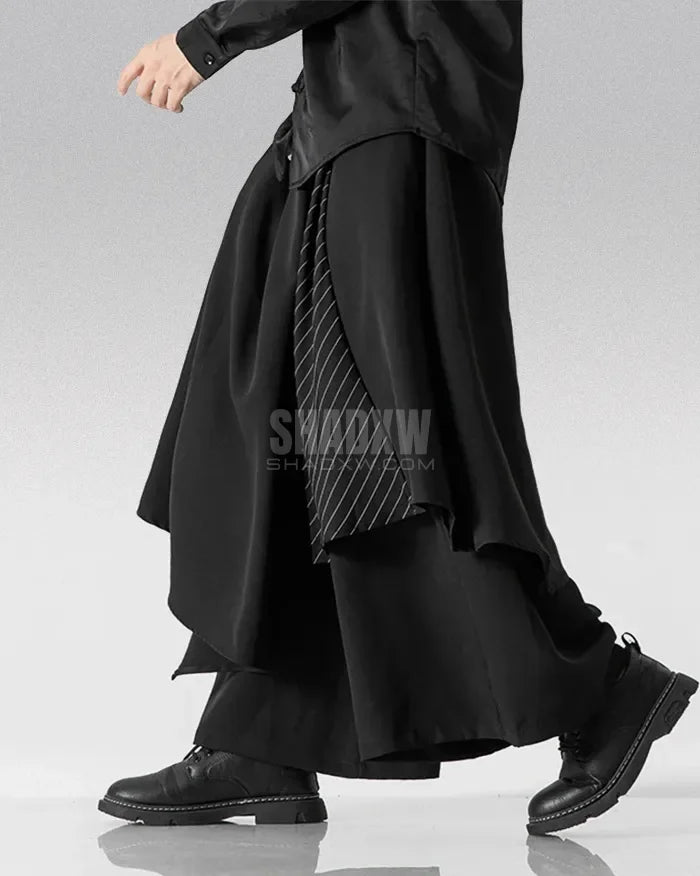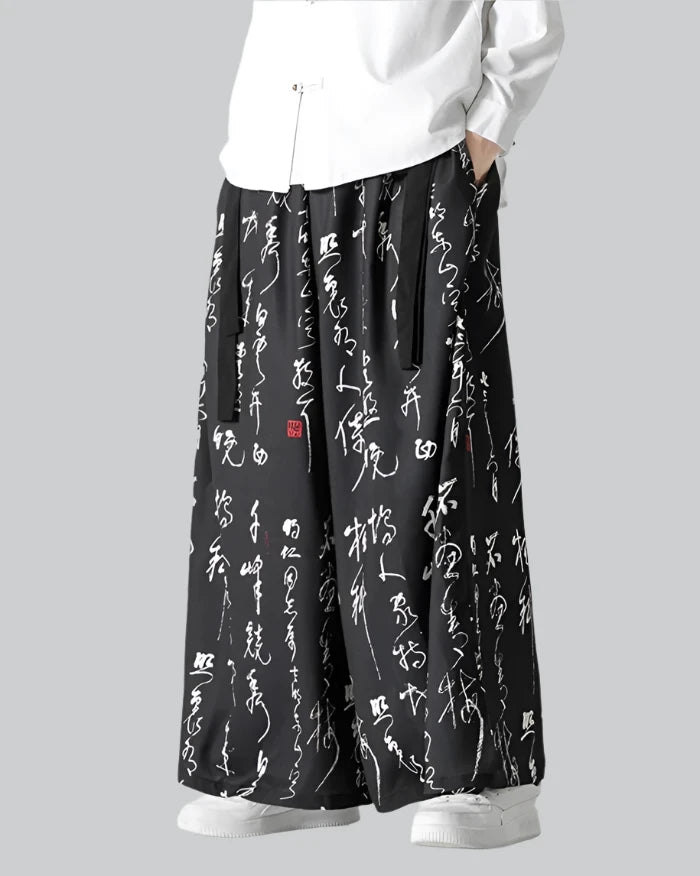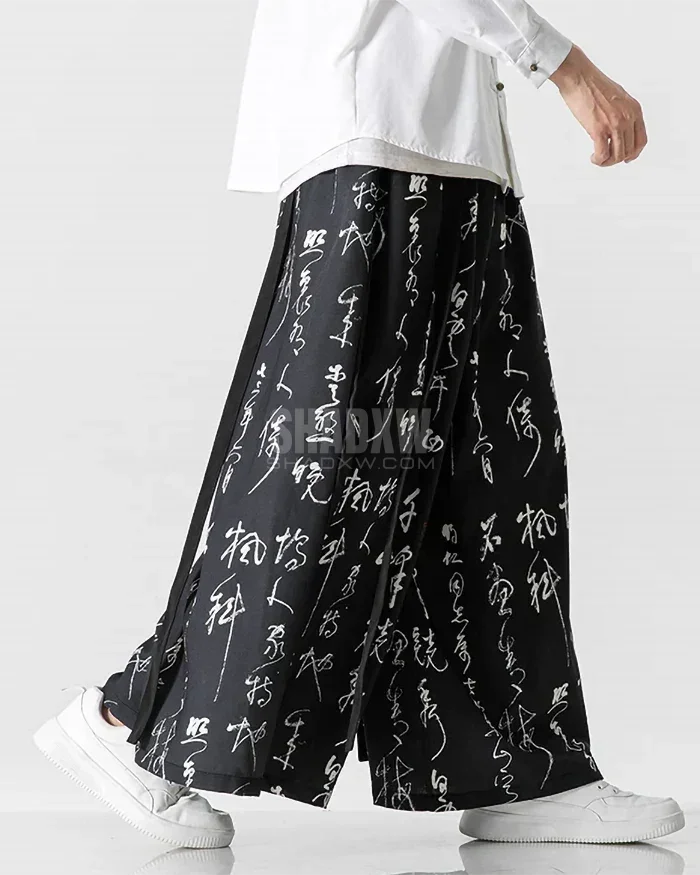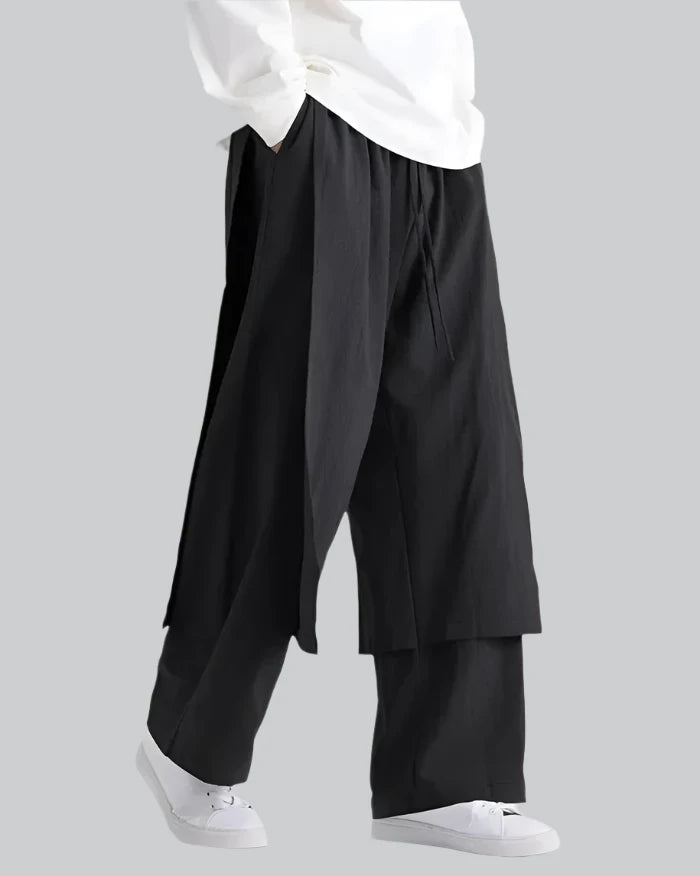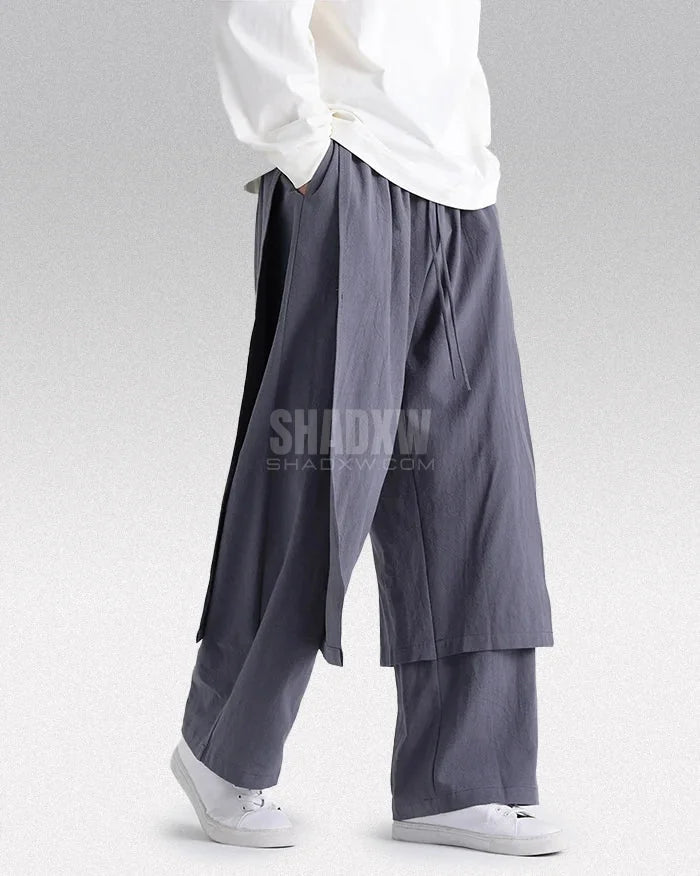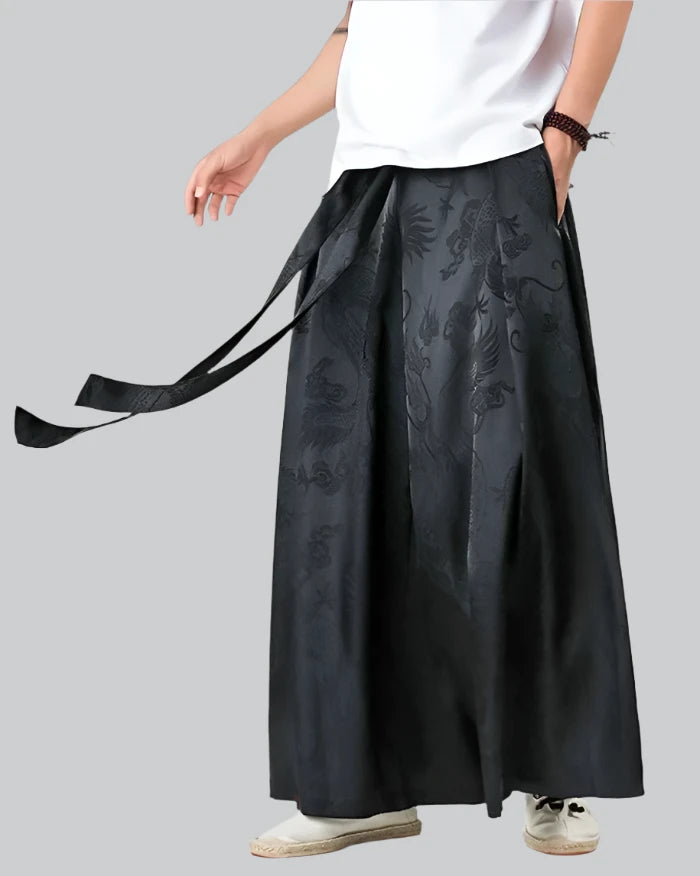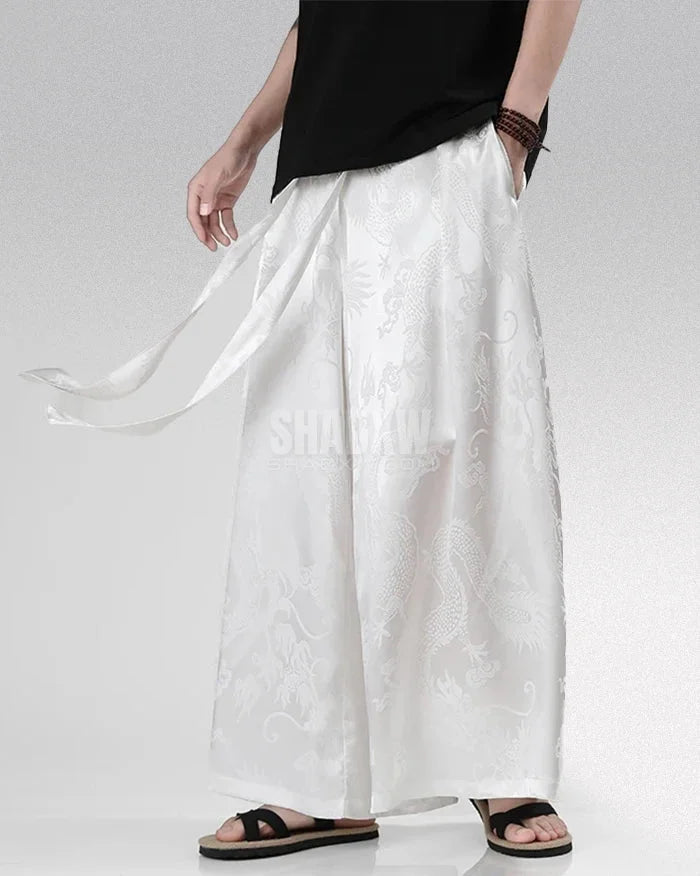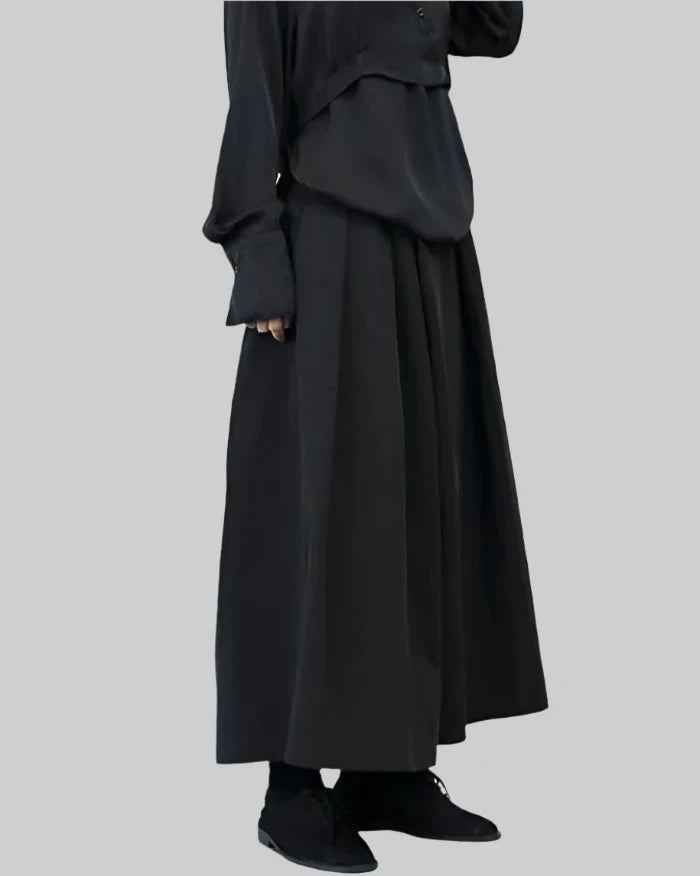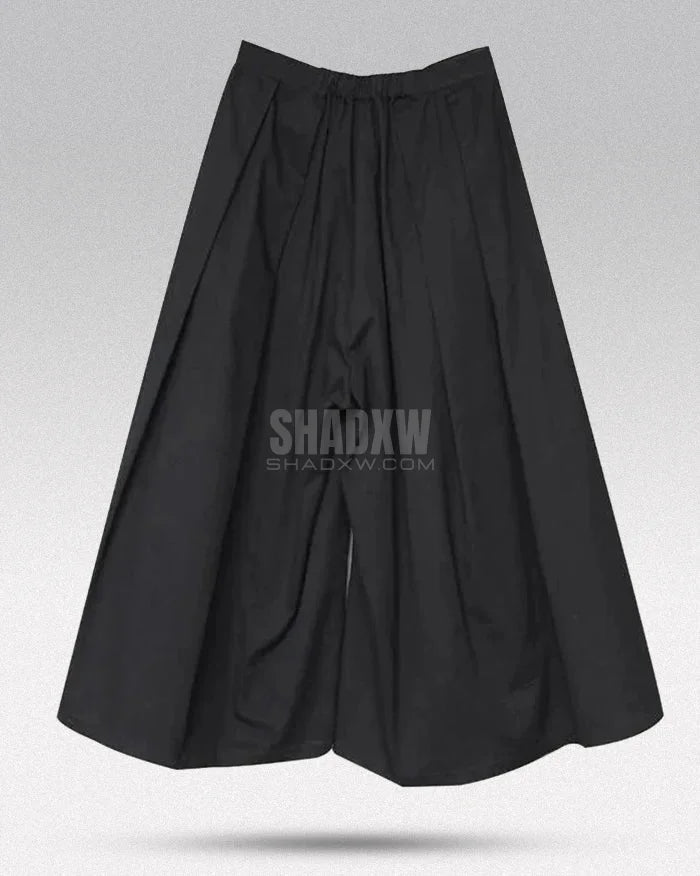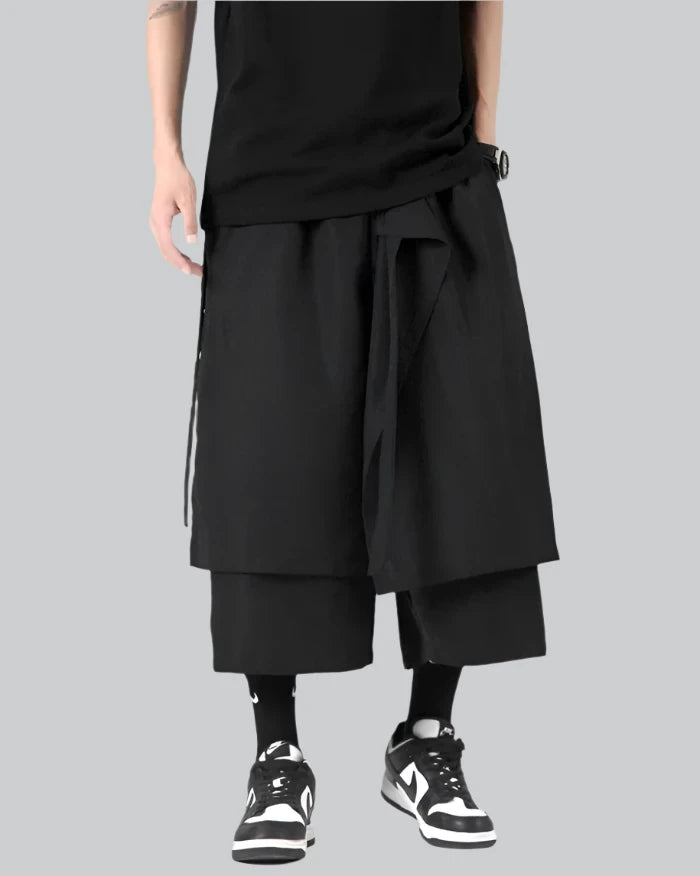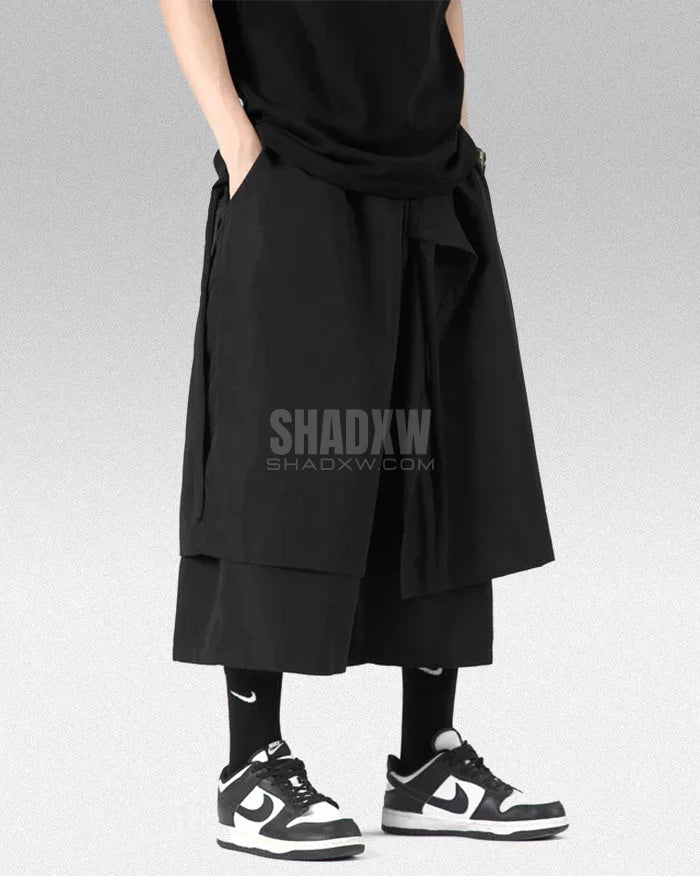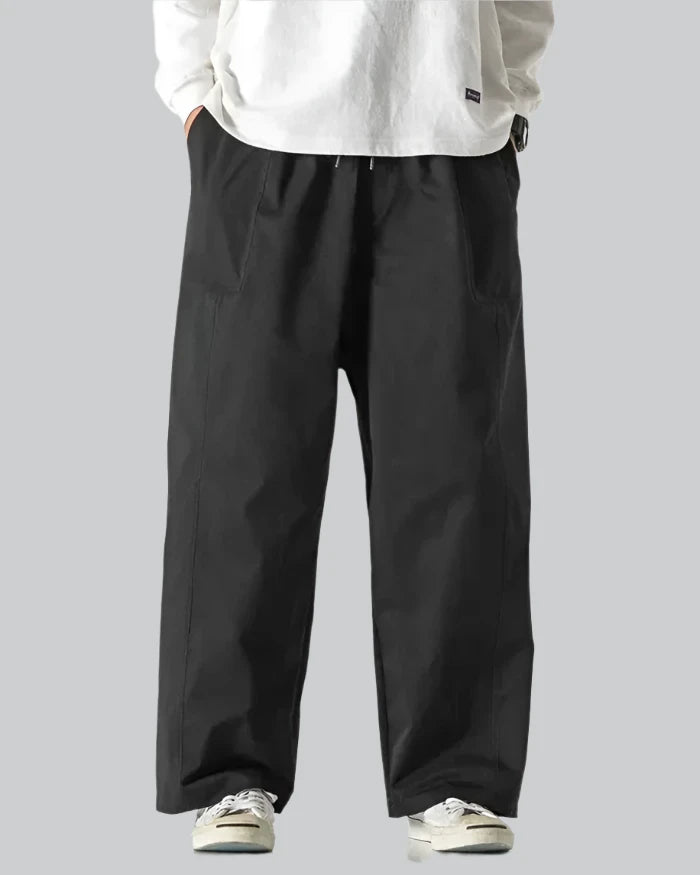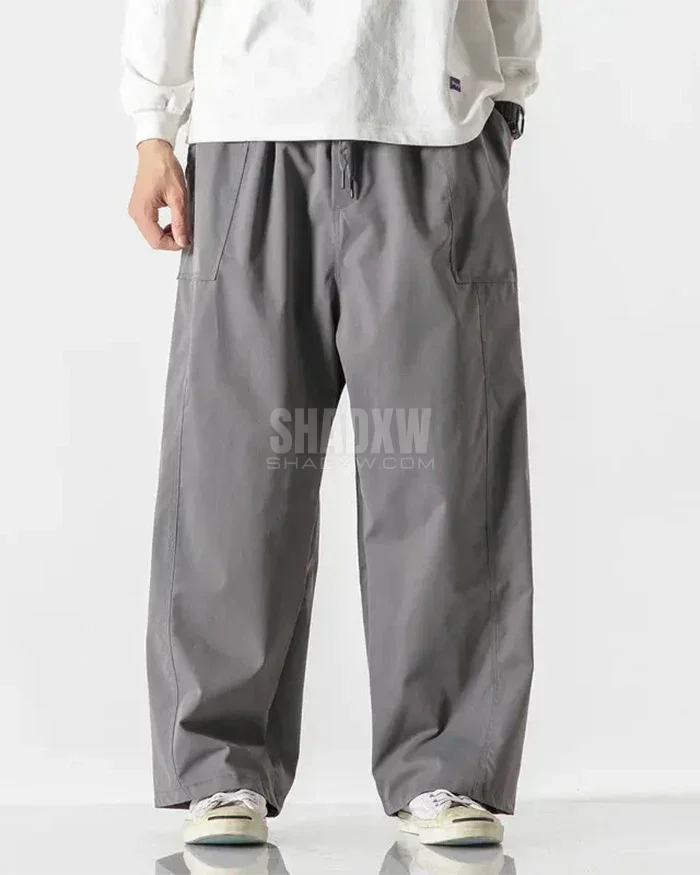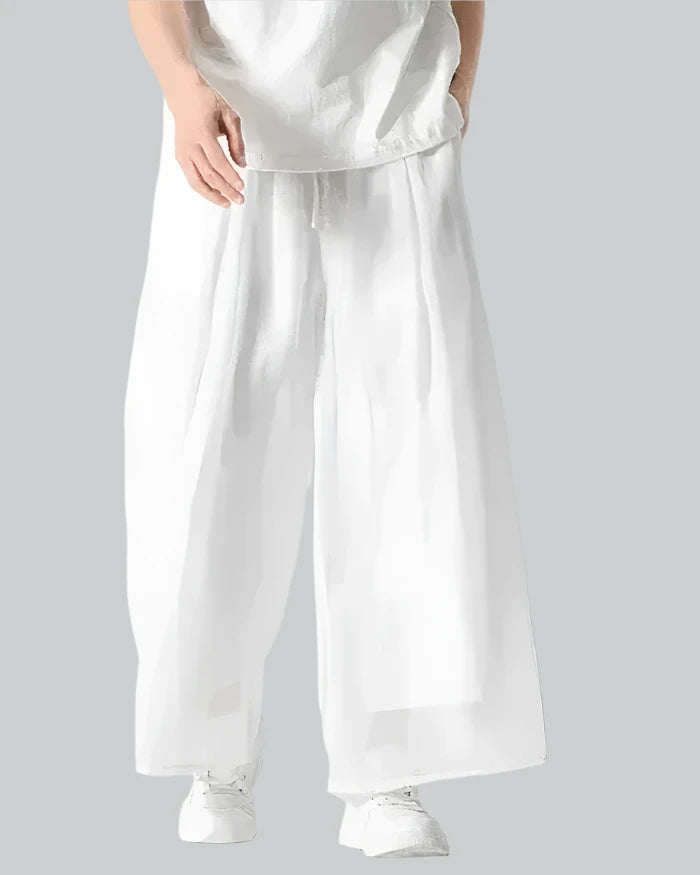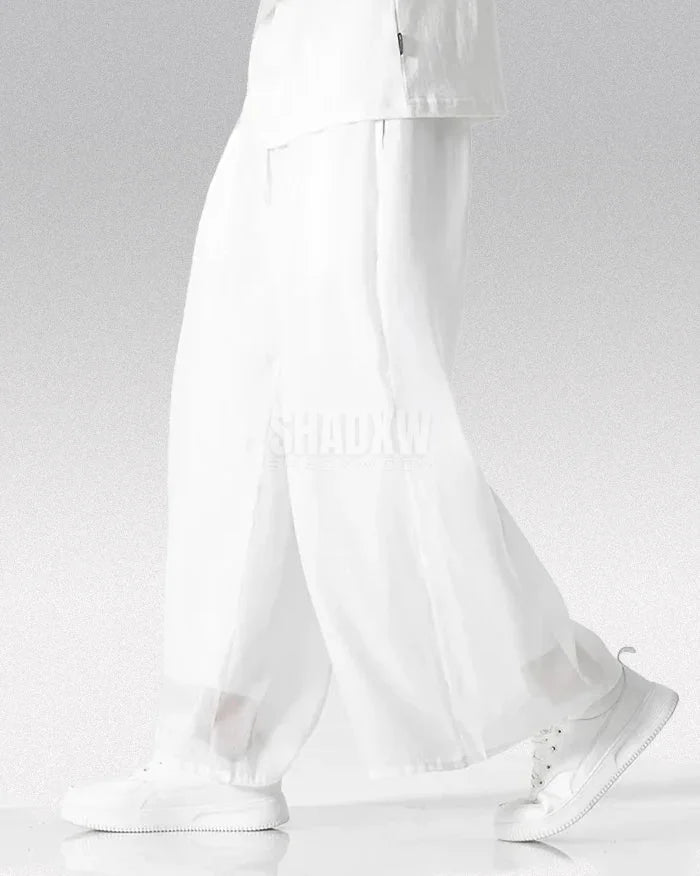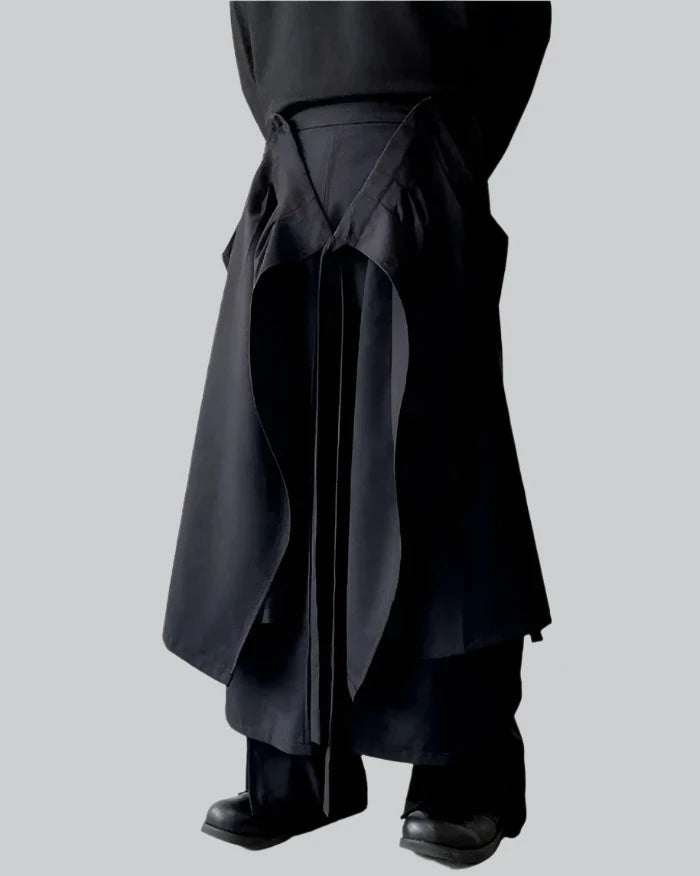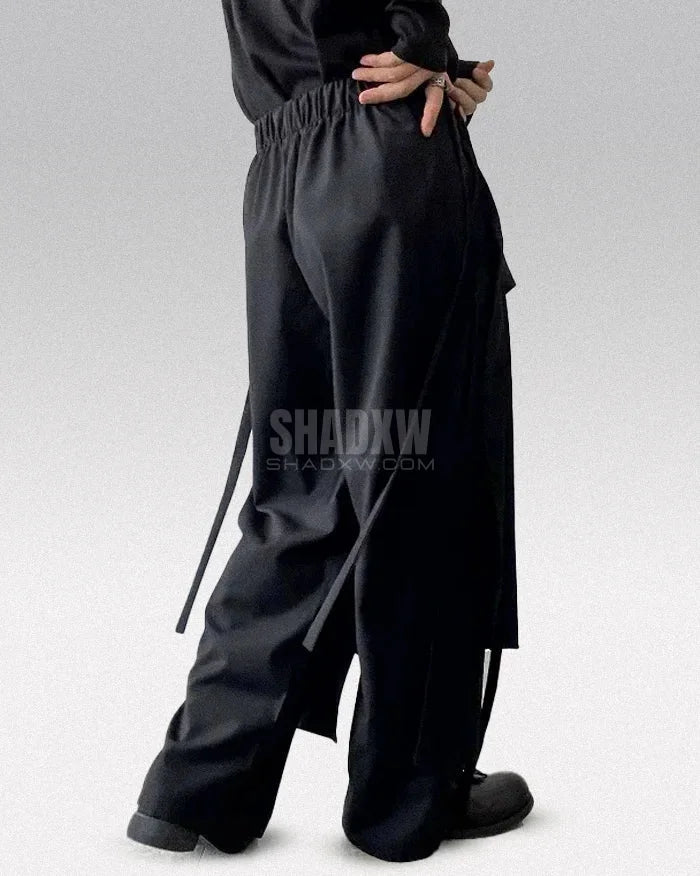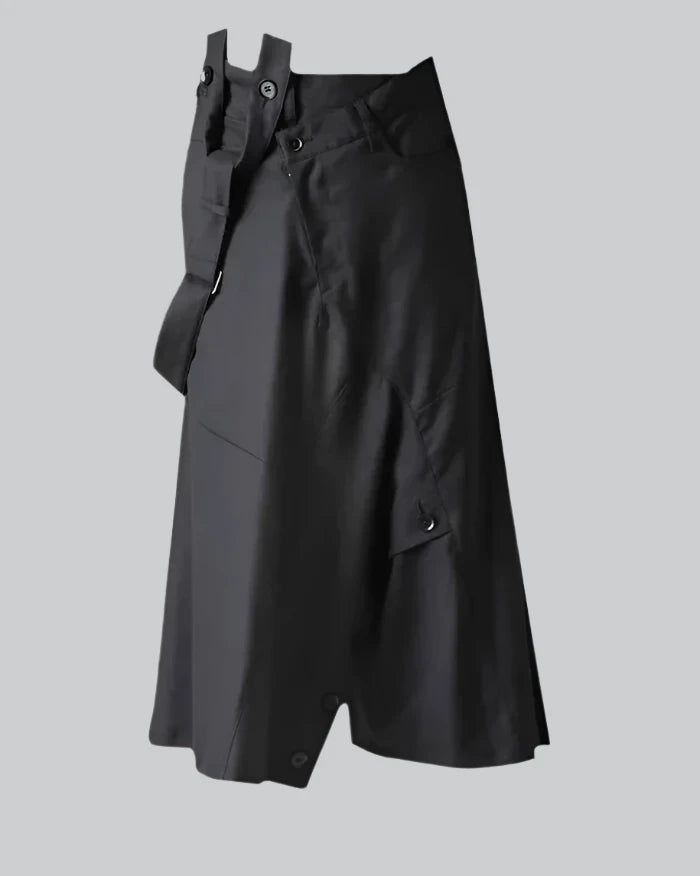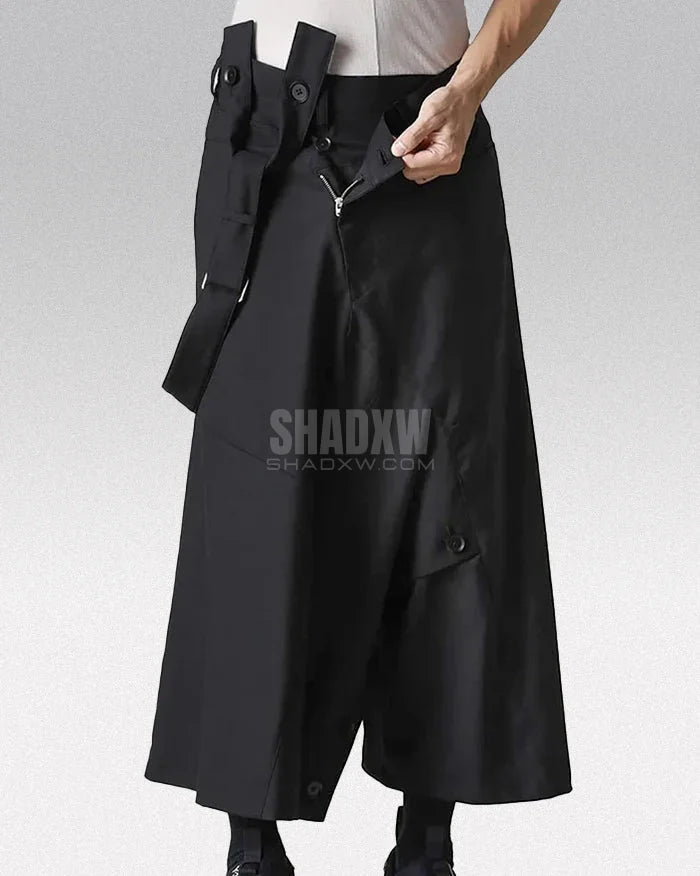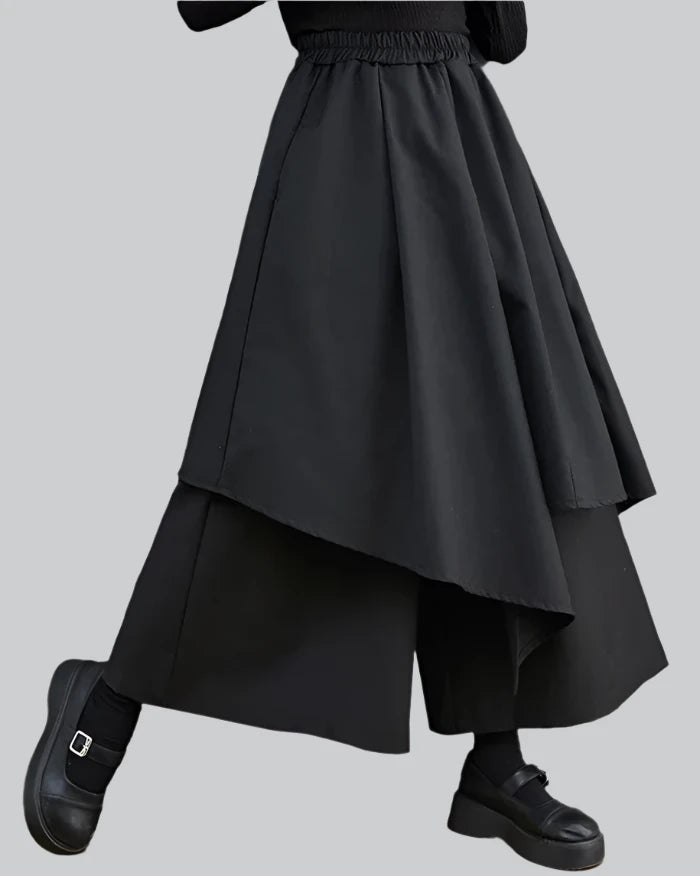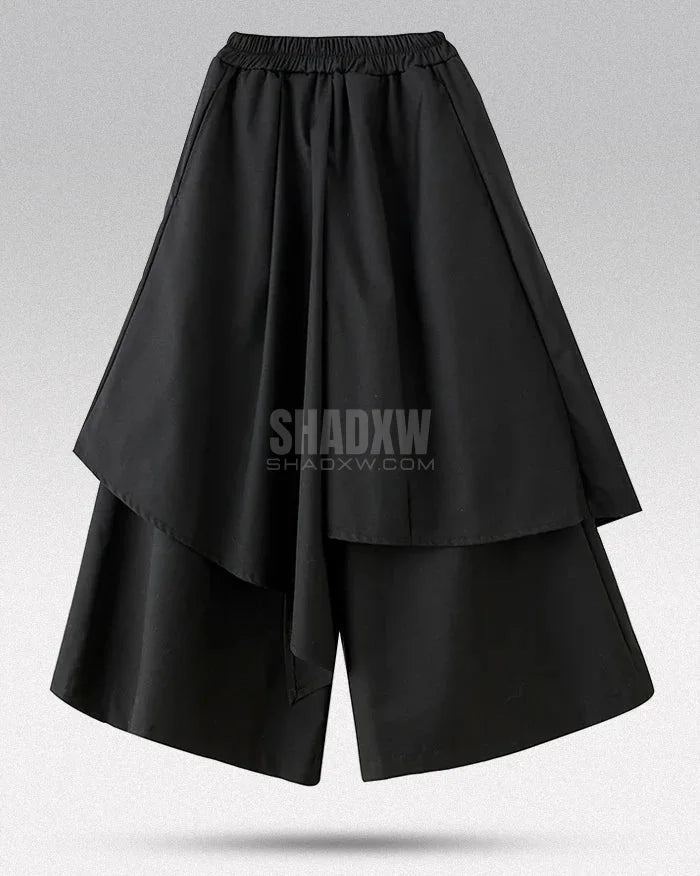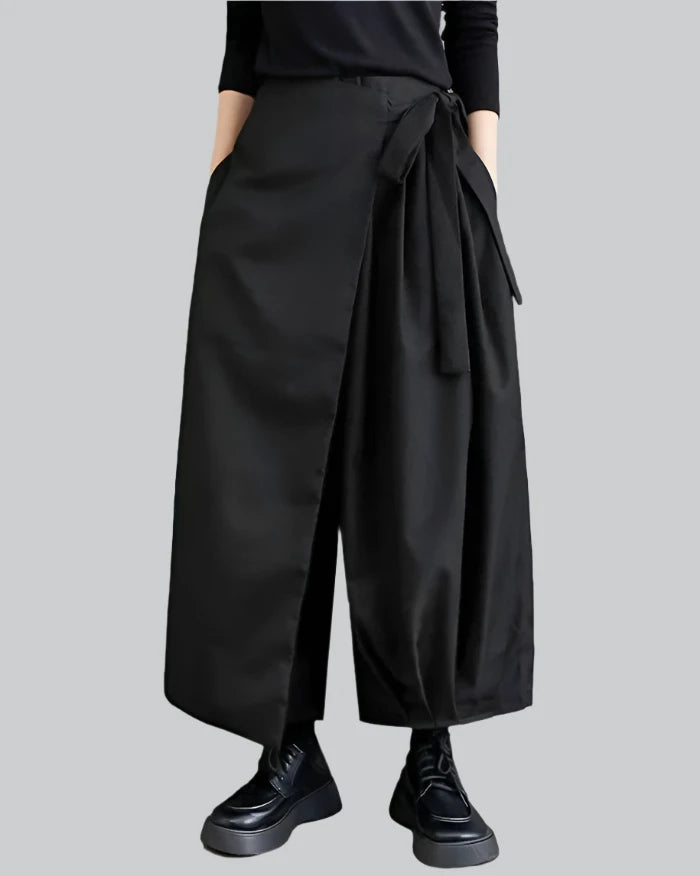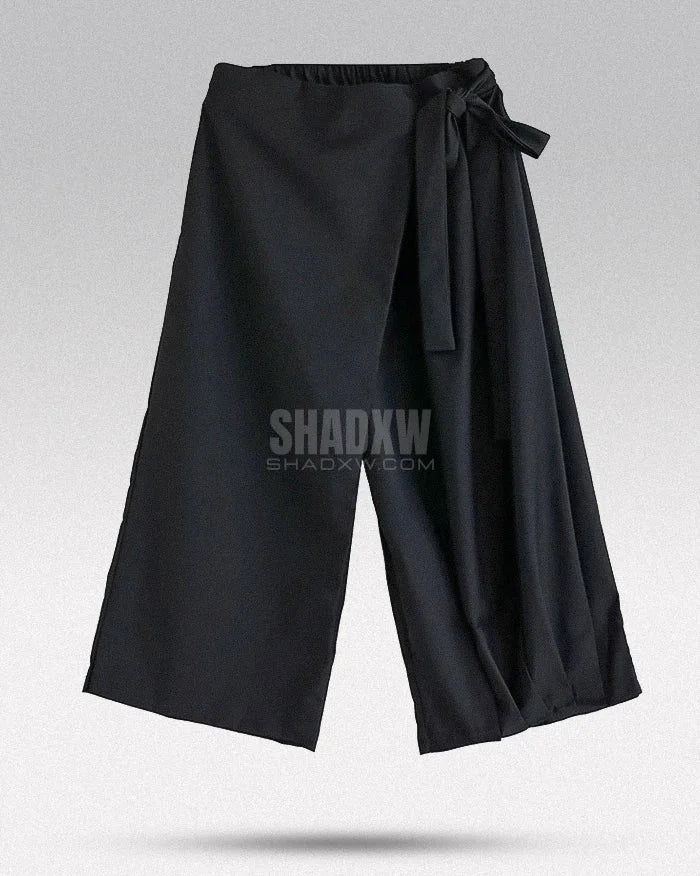Hakama Pants
What are Hakama pants
Hakama pants are traditional Japanese trousers that have been worn for centuries, originating in samurai culture. These wide-leg pants are known for their unique design, which includes pleats that symbolize various virtues like honor, justice, and courage. Hakama pants typically have seven pleats: five in the front and two in the back, each representing a different quality esteemed by the samurai.
Hakama are often tied around the waist and secured with long, adjustable ties known as himo. They are worn over a kimono or gi, making them a common feature in martial arts like kendo, aikido, and iaido. In addition to martial arts, hakama are also part of traditional Shinto rituals and are worn by priests.
There are different types of hakama, including Umanori, which resembles divided pants similar to culottes, and Andon-style, which is undivided, looking more like a skirt. The fabric and color of hakama can indicate status, school, or specific use, adding to their rich cultural and historical importance.
Hakama pants have also influenced modern fashion, with their unique silhouette appealing to those interested in streetwear and avant-garde styles. Today, hakama-inspired designs can be seen in collections that blend traditional Japanese attire with contemporary aesthetics.

Hakama pants come in various types, each designed for different uses and symbolic meanings. The two primary types are Andon Hakama and Umanori Hakama, but there are additional variations as well.
Type of Hakama
Andon Hakama
Andon Hakama, often called the “lantern Hakama,” are undivided and resemble a skirt. This type of Hakama is commonly worn for formal occasions such as ceremonies, traditional performances, and festivals. Andon Hakama are valued for their elegant, flowing appearance and are typically associated with more formal and artistic settings. They allow for a uniform, draped look without the separation of the legs, emphasizing grace and a smooth silhouette.
Umanori Hakama
Umanori Hakama, known as “horse-riding Hakama,” have divided legs, making them functionally similar to trousers. This type was historically favored by samurai as it provided ease of movement while riding horses. Today, Umanori Hakama are often worn in martial arts such as kendo, aikido, and iaido, as they offer the flexibility and range of motion needed for practice while still retaining their traditional look.
Other Types of Hakama
- Nagabakama: These are much longer and extend past the feet, traditionally worn by aristocrats during court ceremonies in ancient Japan. Their extended length was a symbol of high status and could be seen in rituals and performances.
- Hitoe Hakama: A lighter, single-layer Hakama typically used in warmer weather or for informal settings. They offer a cooler, more comfortable option while maintaining traditional pleats.
- Karusan Bakama: A more casual style that dates back to the Edo period. This type looks like culottes and was often worn by townsfolk or performers.
- Mon-tsuki Hakama: A formal version usually paired with a kimono that has a family crest (Mon-tsuki). These are worn for important ceremonies, weddings, or other significant formal events.
Modern Adaptations
In addition to traditional types, modern adaptations of Hakama pants are used in fashion and streetwear. These versions incorporate contemporary materials and designs such as pockets, zippers, and adjustable waist ties, making them more practical for everyday use while still reflecting traditional aesthetics.
Each type of Hakama serves a specific function and carries unique cultural significance, from the divided, practical Umanori Hakama suited for active use to the undivided, formal Andon Hakama that highlight elegance and tradition.
Traditional hakama pants VS techwear hakama pants
Traditional Hakama pants and streetwear-style Hakama (or techwear style hakama pants) are distinct in both their cultural significance and modern adaptations, yet they share a common aesthetic that bridges tradition and contemporary fashion.
Traditional Hakama pants originate from Japan's samurai era and hold deep historical and cultural value. Worn over a kimono or gi, traditional Hakama are most commonly seen in martial arts such as kendo, aikido, and iaido, as well as in Shinto rituals and formal events. Their wide-leg design is characterized by pleats, typically seven in total, which symbolize virtues such as honor, courage, and compassion. These pleats are not just for appearance; they represent the samurai's code of ethics and values. Traditional Hakama can come in various styles, such as Umanori, which resemble divided pants, or Andon-style, which look more like a skirt. The materials used are often natural fabrics like cotton or silk, and the colors are usually neutral or deep, such as black, navy, or white, to reflect formality and tradition.
Streetwear-style Hakama pants, on the other hand, reimagine this traditional garment with a modern twist, integrating elements of contemporary fashion and urban aesthetics. This type of Hakama retains the wide-leg structure but often incorporates innovative cuts, bold colors, and non-traditional fabrics like denim, nylon, or other synthetic materials. Streetwear Hakama are designed to be more versatile and casual, blending seamlessly into everyday outfits. They may feature functional details such as pockets, zippers, and adjustable ties, making them suitable for daily use and aligning with the techwear or urban streetwear ethos. The influence of Japanese fashion culture in streetwear has led to Hakama being styled with oversized hoodies, graphic tees, and sneakers, creating a hybrid look that fuses traditional and contemporary aesthetics.
While traditional Hakama emphasize symbolism, ceremony, and cultural heritage, streetwear-style Hakama focus on personal expression, comfort, and versatility. Traditional versions often maintain a strict adherence to design and etiquette, whereas streetwear adaptations play with proportions, materials, and styling options, reflecting the wearer’s unique sense of fashion.
In terms of styling, traditional Hakama are usually worn with a kimono or martial arts gi and are tied with specific techniques to ensure proper draping. Streetwear Hakama, however, can be paired with modern pieces such as techwear jackets, tactical vests, and chunky sneakers. This adaptability makes streetwear Hakama appealing to those who appreciate fusion fashion—a blend of cultural roots and global trends.
Both styles have their own merits. Traditional Hakama resonate with those interested in Japanese culture and heritage, martial arts, or ceremonial purposes, providing a connection to the past and the virtues they embody. Streetwear Hakama appeal to the fashion-forward individual who appreciates the blend of history and modern design, seeking to make a statement that nods to traditional craftsmanship while embracing contemporary urban style.

How to put on Hakama pants
Putting on Hakama pants requires attention to detail to ensure they are worn correctly and comfortably. Here’s a step-by-step guide to help you put on Hakama pants properly:
1. Start with the Right Clothing
Before putting on the Hakama, wear a kimono, gi, or appropriate martial arts uniform. This base layer ensures that the Hakama stays in place and looks traditional.
2. Hold the Hakama Correctly
Pick up the Hakama pants by holding the front ties (himo). Ensure the front part is facing you and the back part, with the koshi-ita (the stiff back panel), is behind.
3. Position the Front
Wrap the front part of the Hakama around your waist, aligning it at the desired height, typically around the waist or just below the navel. Make sure the pleats are lying flat and centered.
4. Secure the Front Ties
Cross the front himo behind your back, then bring them forward around your waist. Tie them securely in the front, using a simple knot or a bow.
5. Position the Back Panel
Lift the back of the Hakama and place the koshi-ita (stiff back plate) against the small of your back. Ensure it sits comfortably and aligns with your spine.
6. Tie the Back Ties
Bring the back himo around your waist, crossing them at the front. You can either tie these behind your back or bring them back around to the front again, depending on tradition and preference. A standard option is to create a decorative bow knot or an aesthetic tie in the front.
7. Adjust and Check
Make sure the pleats on both the front and back are neat and even. The Hakama pants should feel secure but not too tight, allowing free movement for martial arts practice or formal occasions.
8. Final Check
Ensure that the Hakama is properly aligned, symmetrical, and comfortable. Adjust the pleats and ties as necessary to maintain a clean and traditional appearance.
Pro Tips:
- Maintain the Pleats: Ensure the pleats remain flat and evenly spaced for a polished look.
- Practice: Putting on Hakama can take some practice to perfect, especially if worn for ceremonial or martial arts purposes.
- Secure Ties: The himo should be secure enough to hold the Hakama in place during activity but not so tight as to restrict movement.
This step-by-step guide ensures you wear Hakama pants in a manner that respects their traditional roots while providing comfort and style. Properly wearing Hakama can enhance your performance in martial arts or give you an authentic look in formal settings.
How to style your hakama pants in with Techwear
Pairing Hakama pants with techwear outfits can create a unique blend of traditional Japanese fashion and modern urban aesthetics. Here's a guide on how to achieve this fusion while maintaining a stylish, cohesive look:
1. Choose the Right Hakama Pants
Opt for Hakama pants made from modern, durable materials like cotton blends or technical fabrics that align with techwear's practical focus. Look for neutral colors such as black, gray, or dark green to maintain the urban look.
2. Layer with a Functional Top
Pair your Hakama pants with a techwear jacket, hoodie, or oversized top that features tech elements like zippers, straps, or pockets. A waterproof jacket or a windbreaker with asymmetrical cuts complements the flowing structure of the Hakama and enhances the overall silhouette.
3. Focus on Footwear
Select footwear that complements both the traditional and modern elements. High-top sneakers, combat boots, or chunky sole shoes work well with the wide-leg nature of Hakama pants, adding a touch of urban edginess. Choose footwear in colors that match or subtly contrast with the Hakama.
4. Accessorize with Purpose
Add techwear accessories like utility belts, multi-pocket bags, or sling pouches. These items add a futuristic touch and serve as practical elements. Harnesses or strapped gear can also add dimension and create a cohesive techwear aesthetic that complements the structure of Hakama pants.
5. Layer with Outerwear
Consider layering with oversized coats, technical vests, or long jackets that fall just above or below the Hakama. This can create an interesting play on lengths and shapes while keeping the look practical and weather-appropriate.
6. Play with Textures
Techwear often incorporates materials like GORE-TEX, nylon, and mesh, which can contrast beautifully with the more traditional fabric of Hakama pants. Mixing these textures adds depth and interest to the outfit.
7. Keep It Minimal
Techwear is known for its functional minimalism, so avoid over-accessorizing or choosing overly bright colors that clash with the muted palette of techwear. A streamlined approach with a focus on functionality and comfort will make the Hakama-techwear blend feel intentional and refined.
8. Use Tactical Layers
Hakama pants are flowy and wide, so balance this with fitted or structured pieces on the upper body, such as tactical vests or form-fitting tech tops. This creates a dynamic silhouette that combines the traditional drape of the Hakama with the urban precision of techwear.

Hakama pants care instructions
How to wash your hakama pants
To properly care for Hakama pants, it is essential to follow specific steps that help maintain their shape, fabric integrity, and pleats. Begin by reading the care label to check for any special washing instructions based on the fabric type, as different materials may have unique requirements. For most Hakama, hand washing is the preferred method. Using cold water and a gentle detergent helps to keep the fabric strong and prevents the pleats from becoming distorted. If hand washing is not an option, a delicate cycle on a washing machine can be used, but it is crucial to place the Hakama in a mesh laundry bag to reduce agitation and maintain the pleats' integrity. Harsh chemicals, such as bleach or strong fabric softeners, should be avoided as they can damage the fabric or cause it to fade over time.
How to dry your hakama pants
When it comes to drying, air drying is the safest option. Hang the Hakama pants on a clothesline or drying rack, ensuring the pleats are laid out neatly and are not wrinkled. Direct sunlight can cause the fabric to fade, so it is best to choose a shaded or indoor space for drying. Avoid twisting or wringing out the Hakama, as this can lead to permanent creases or damage.
Ironing Hakama pants should be done with care to preserve the pleats. Using a low heat setting on the iron is ideal, and placing a pressing cloth between the iron and the fabric will prevent direct heat from damaging the material. For those who prefer a gentler approach, a garment steamer is effective for removing wrinkles while preserving the pleats' structure. When using a steamer, maintain a slight distance from the fabric to avoid soaking it.
How to store your hakama pants
Storing Hakama pants is just as important as washing and drying. Properly folding them ensures the pleats remain sharp and the fabric stays in good condition. Fold the Hakama along the natural pleats and place it in a drawer or on a flat surface where it will not be compressed by other items. For an even better solution, hang the Hakama by its waist ties on a hanger, which helps preserve the shape and minimizes the need for ironing. If the Hakama is made from natural fibers like wool or cotton, consider using moth repellents in the storage area to avoid damage from insects.
How to fold your hakama pants
Folding Hakama pants properly is essential to maintain their structure, prevent wrinkles, and preserve the pleats. Here's a detailed step-by-step guide on how to fold Hakama pants:
1. Lay the Hakama Flat
Start by placing the Hakama pants on a flat surface with the front side facing up. Smooth out any wrinkles to ensure a clean fold.
2. Straighten the Pleats
Align the five front pleats by carefully straightening them out. The pleats should be parallel and lay flat. This step is crucial to maintain the defined look of the pleats.
3. Fold the Sides
Bring the left and right sides of the Hakama inward so that the pleats stay aligned and the Hakama takes a more rectangular shape. Ensure the himo (ties) are out of the way during this step.
4. Fold in Half Lengthwise
Fold the Hakama in half lengthwise by bringing the bottom edge up to the waistband. Make sure that the koshi-ita (the stiff back panel) stays flat and doesn’t create extra bulk.
5. Fold the Ties
Lay the himo straight, one at a time. Start with the front ties: cross them over each other neatly on top of the folded Hakama. Repeat this with the back ties, folding them over the front ties in a crisscross pattern or arranging them in an X shape.
6. Fold in Thirds or Fourths
Depending on the length of the Hakama, fold the garment into thirds or fourths from top to bottom to create a compact shape. The final folded piece should be rectangular and neatly arranged.
7. Secure the Fold
Wrap the himo around the folded Hakama to secure it in place. This helps to keep the pleats intact and the Hakama tidy during storage or transport.
Pro Tips for Folding Hakama:
- Ensure Smooth Pleats: Take extra care when straightening the pleats at the beginning, as it makes the entire folding process easier and ensures the Hakama keeps its sharp, defined look.
- Practice Patience: Folding Hakama can be time-consuming at first, but with practice, it becomes quicker and easier.
- Store Properly: Always store your Hakama in a cool, dry place to prevent the fabric from creasing or getting damaged.
If you are looking for a summer outfit, opt for one of our techwear shorts, the perfect summer techwear apparel that blend comfort and utility.
Filters
62 products
Free shipping
No minimum purchase. Just stylish techwear delivered right to your door.
Secure payment
Shop with Confidence! Our secure payment gateway ensures your information stays protected.
Satisfied or money-back
Not 100% Satisfied? No worries! You have 14 days to return or exchange your items.
Need help?
Here to help, 7/7: info@shadxw.com

